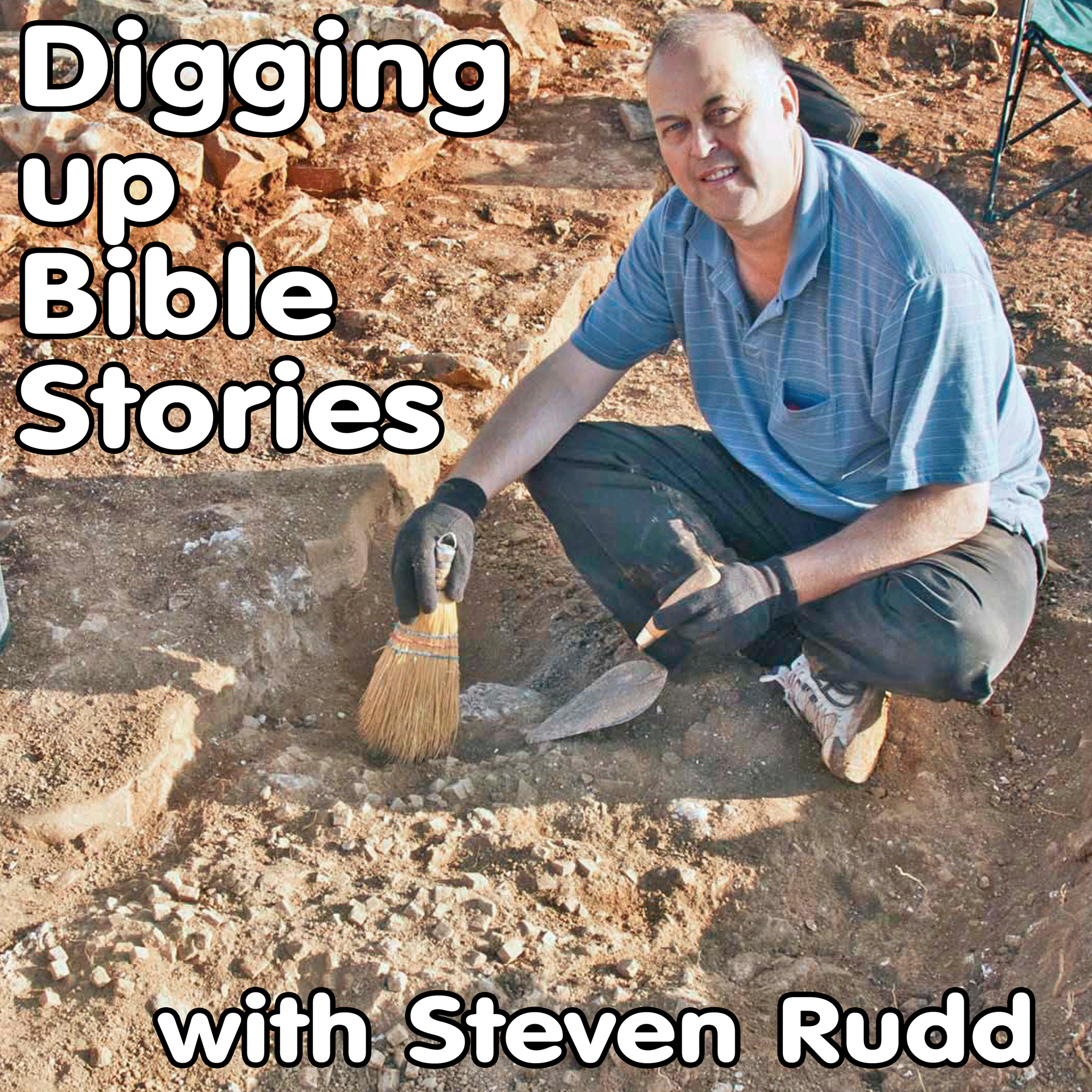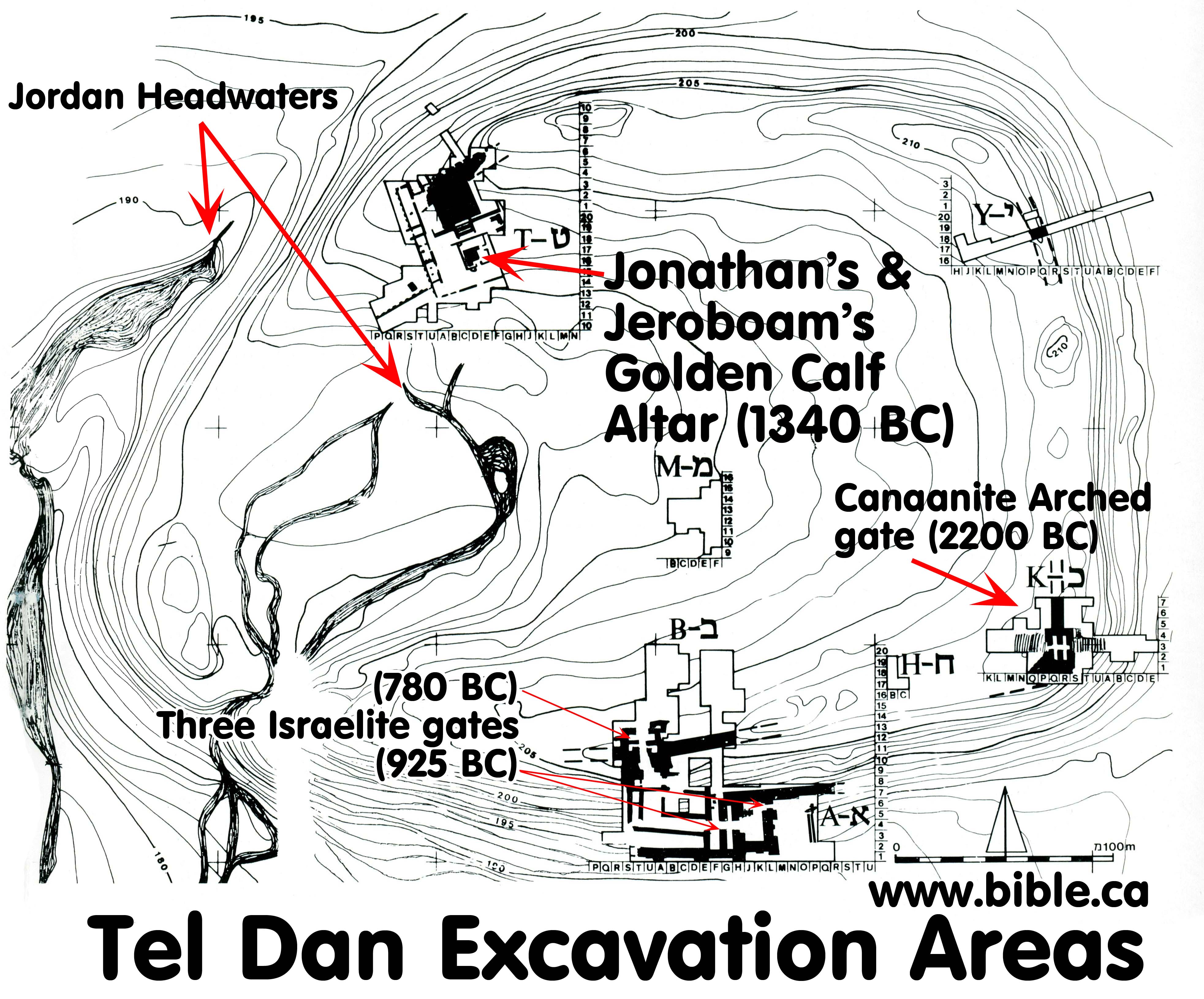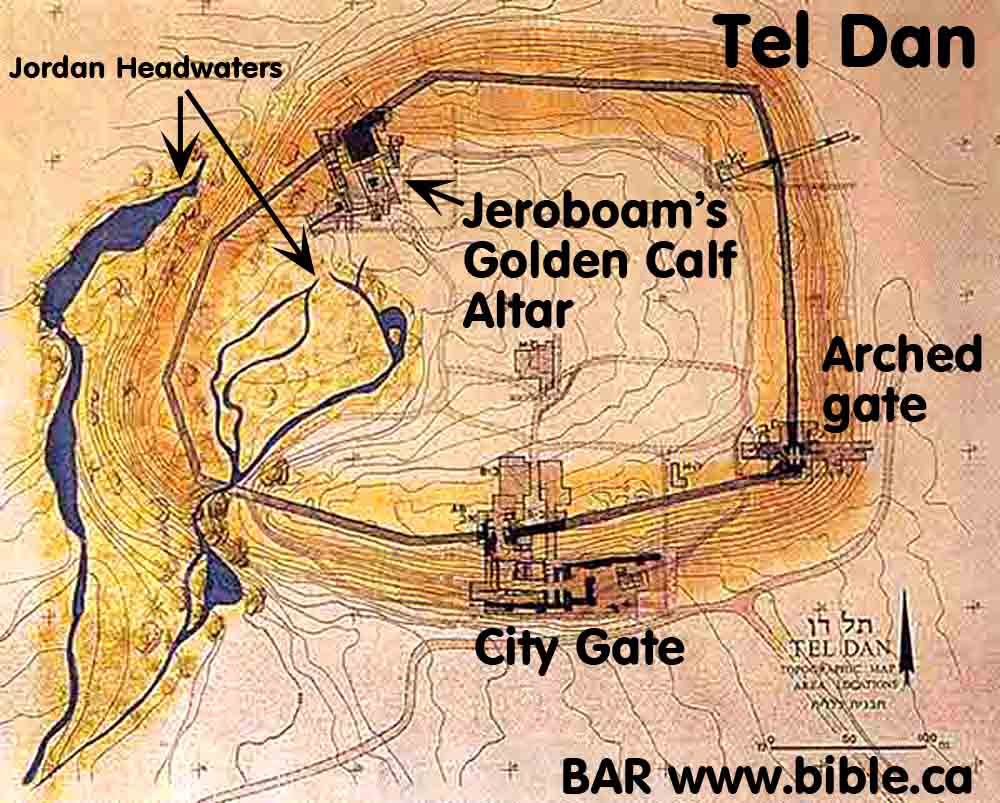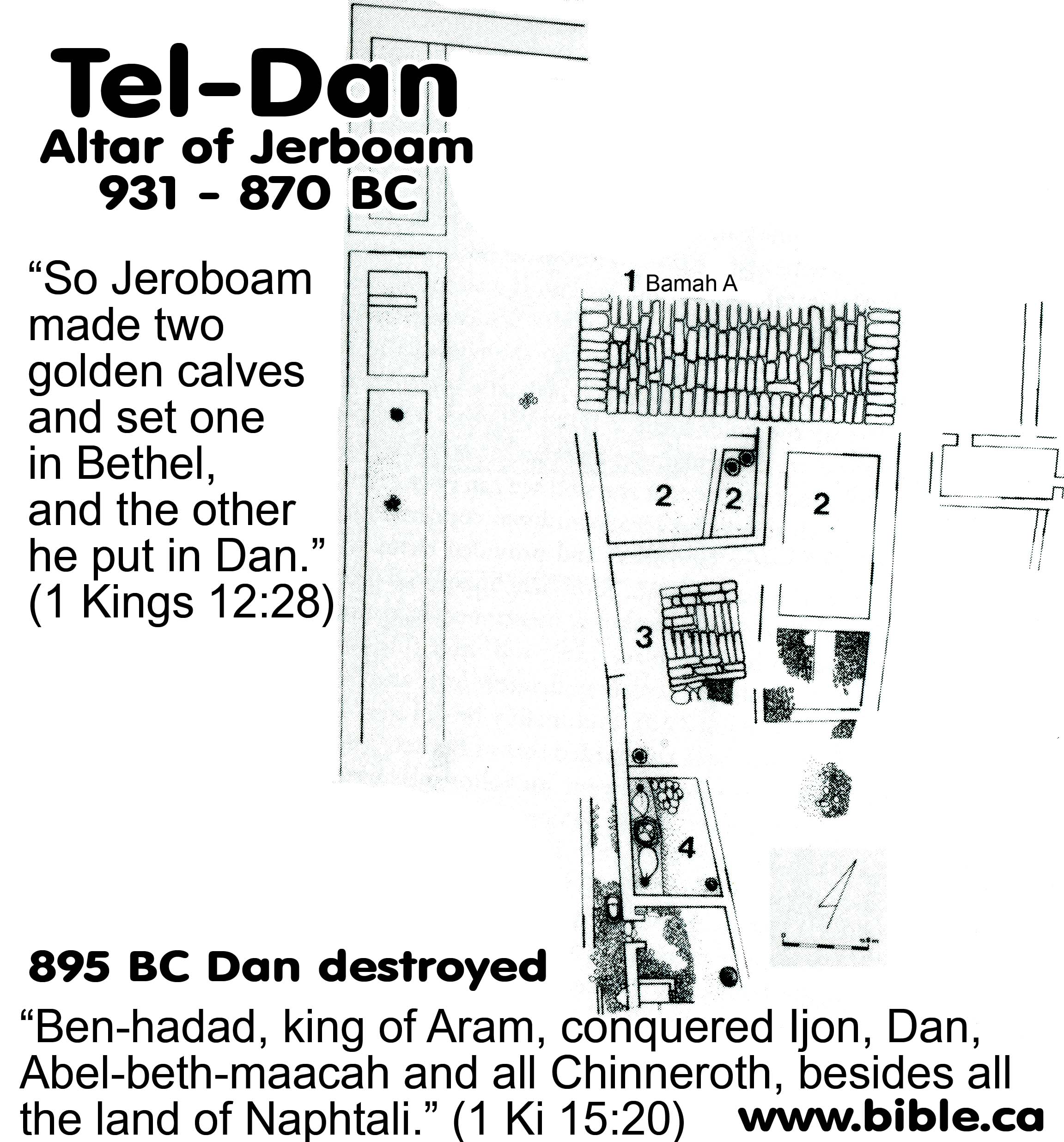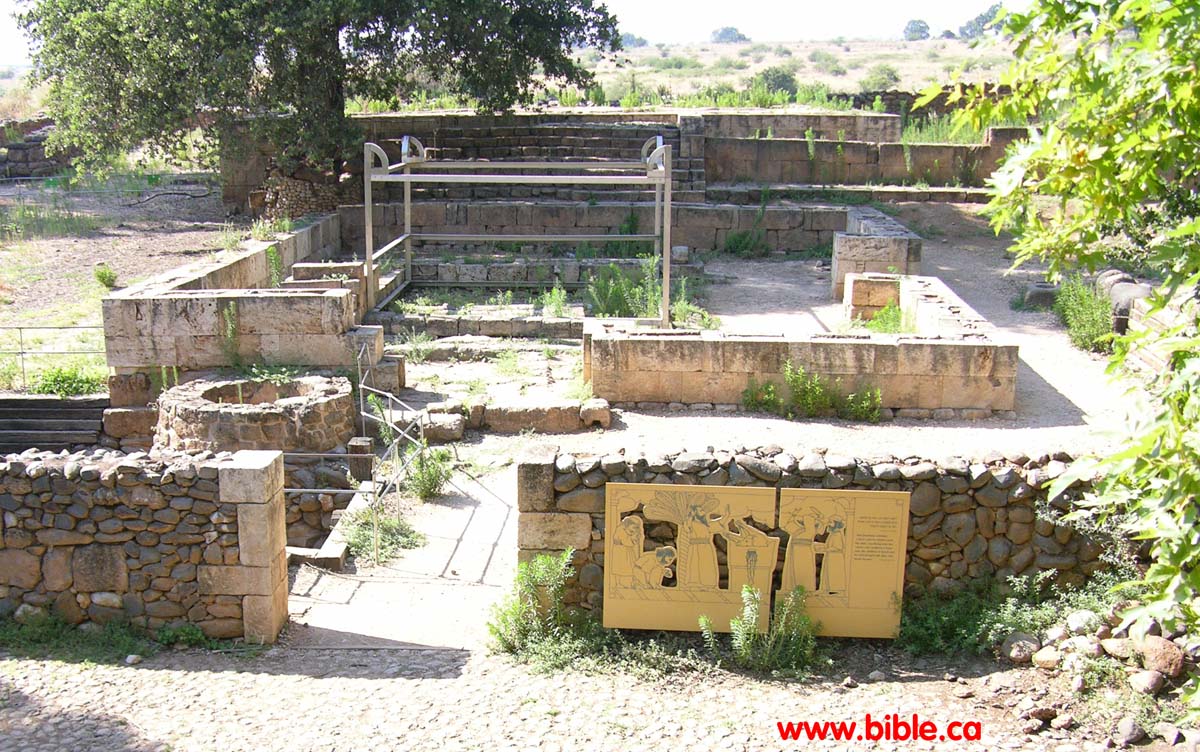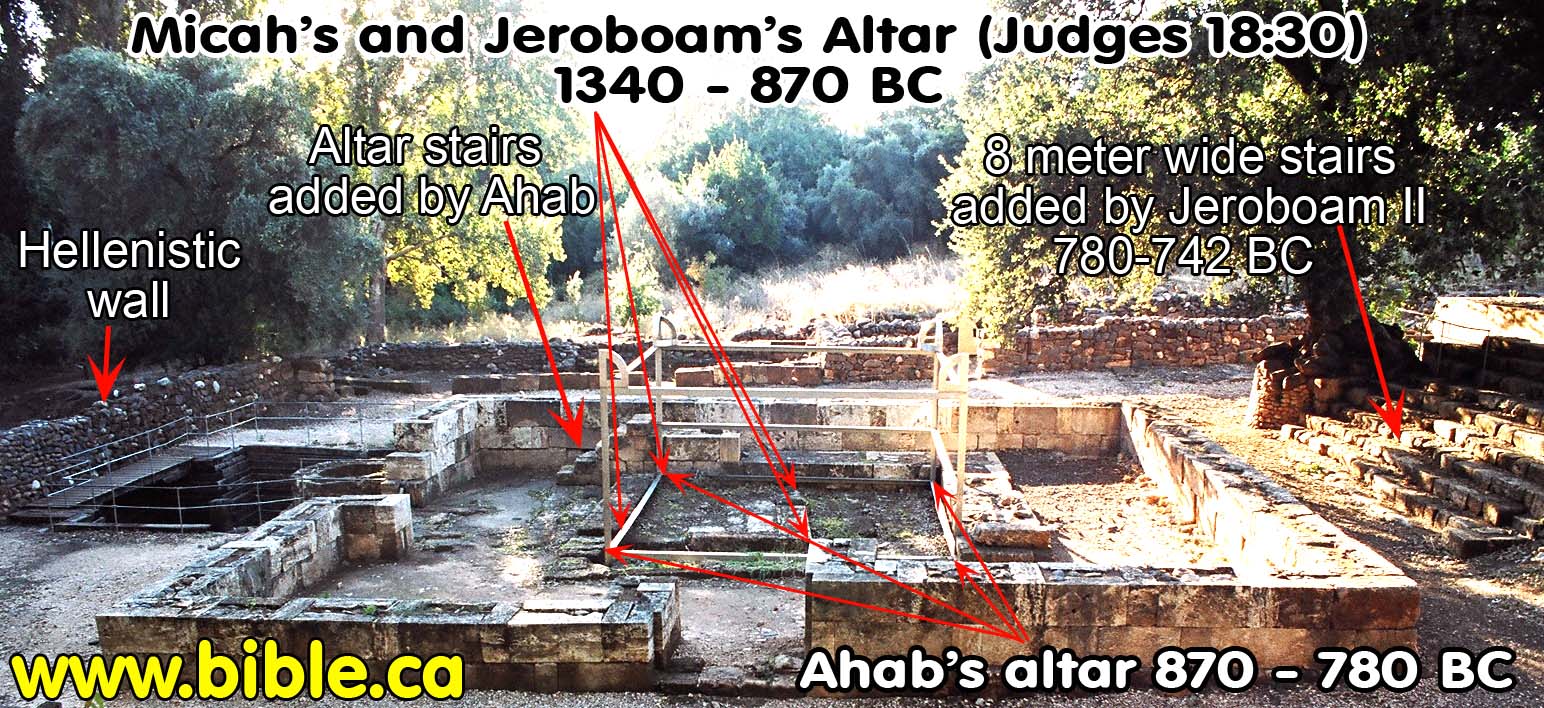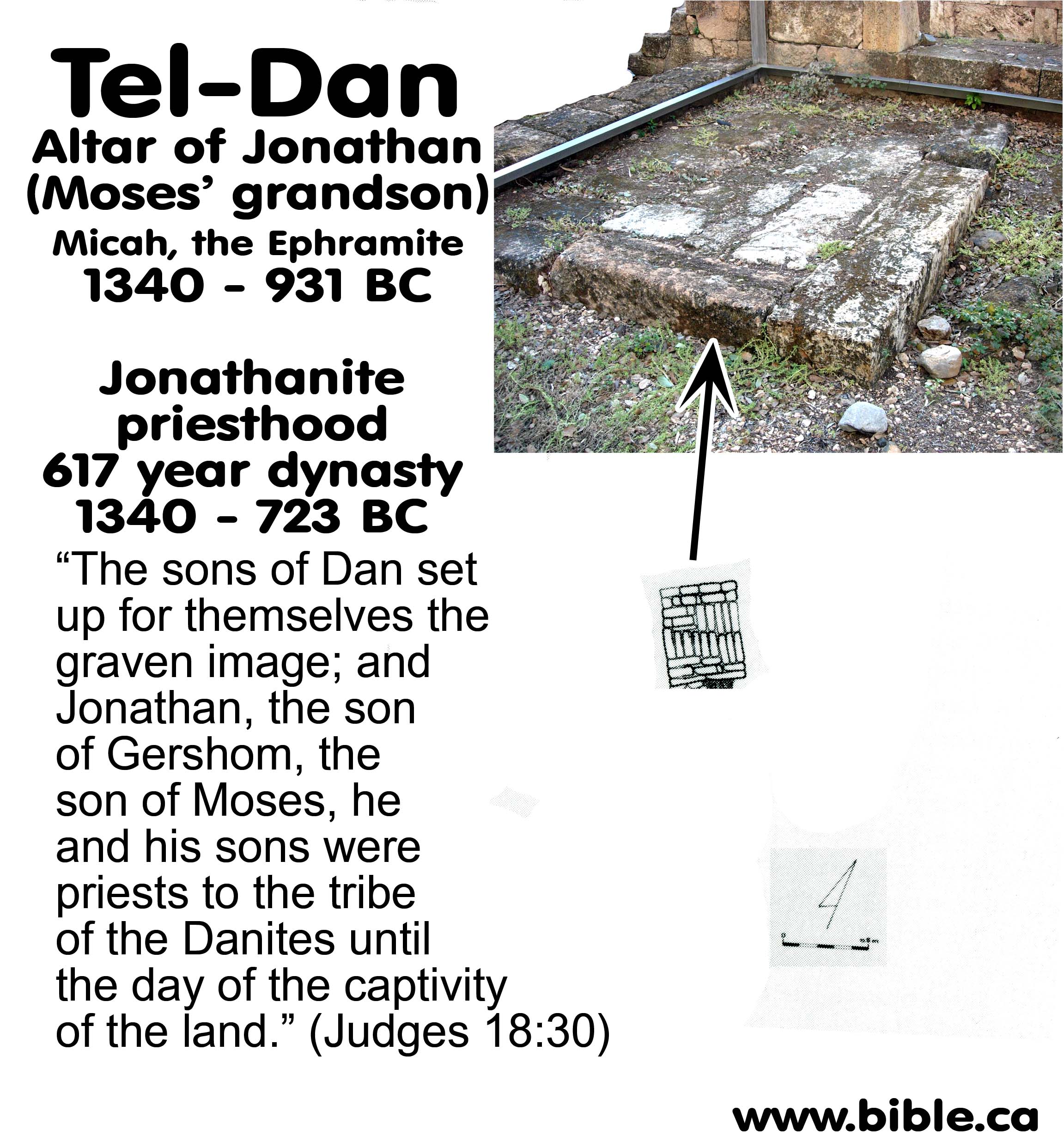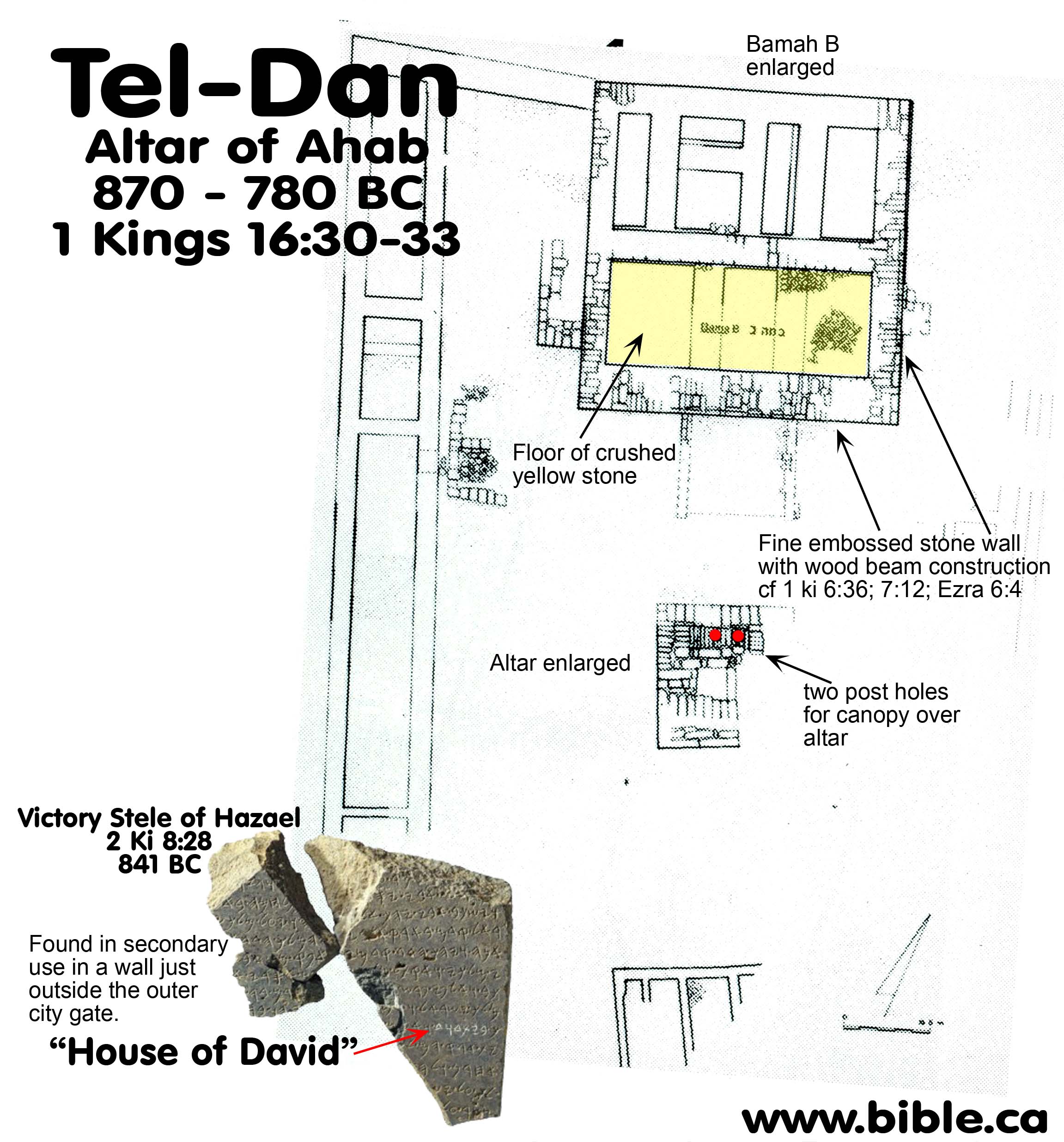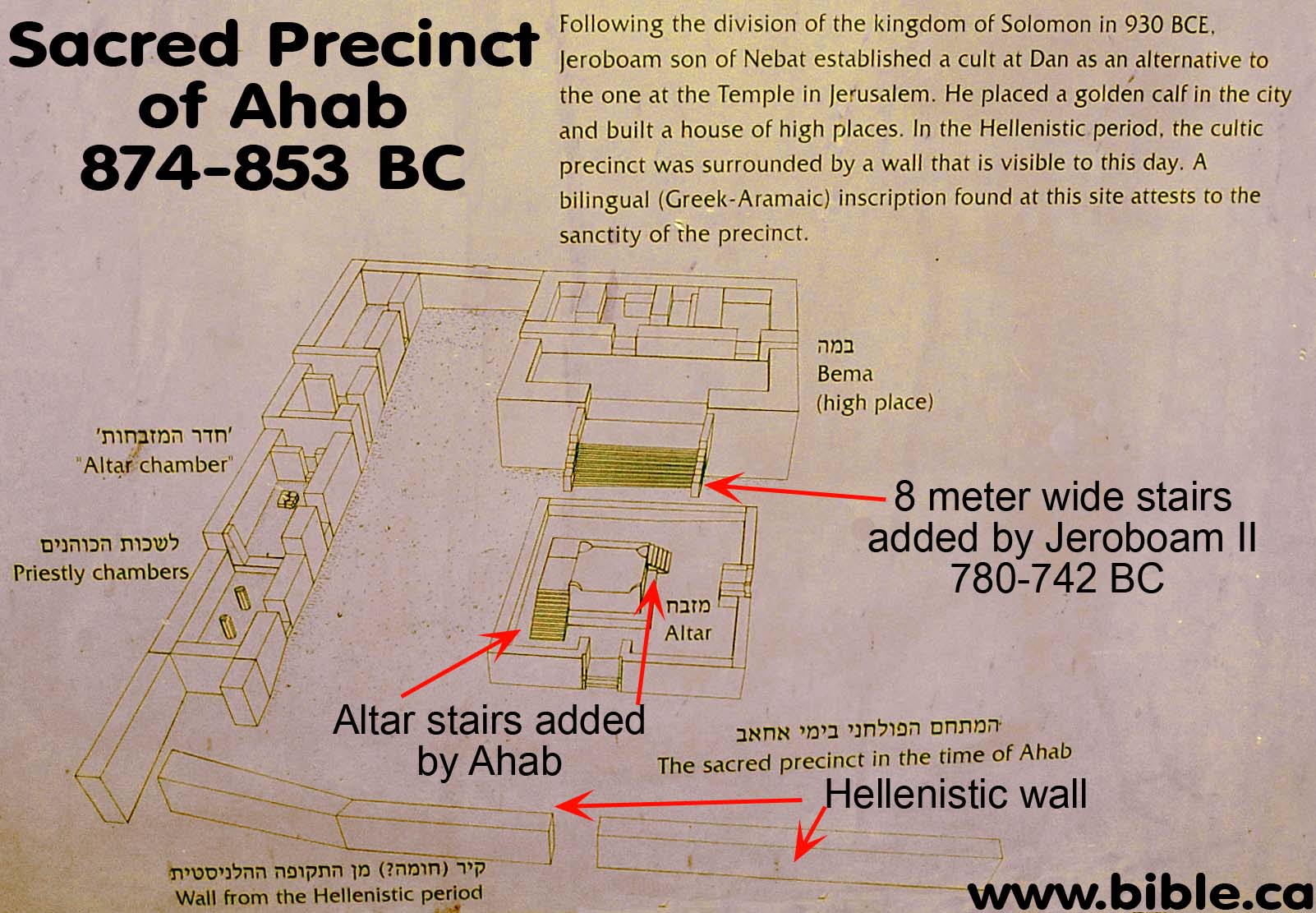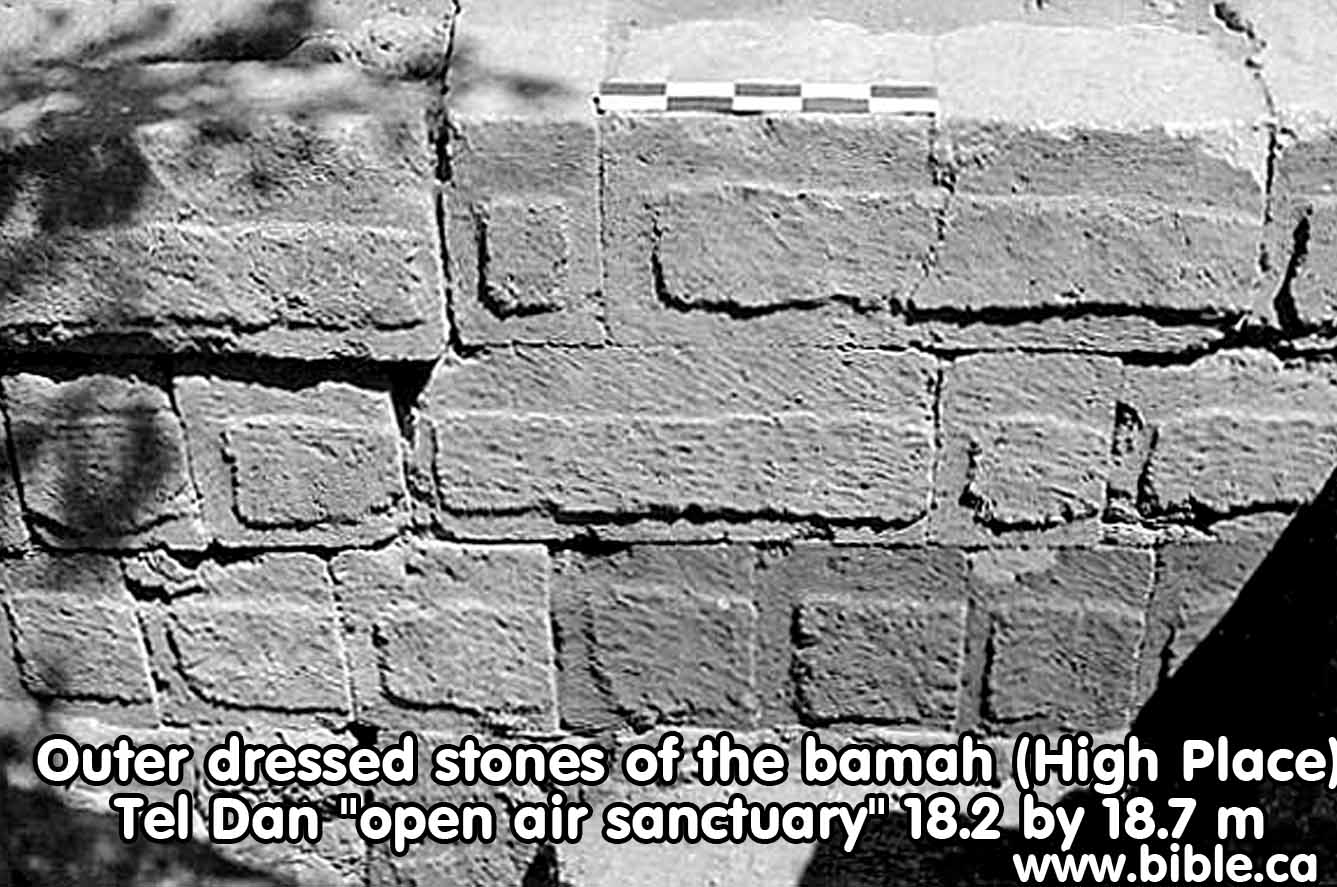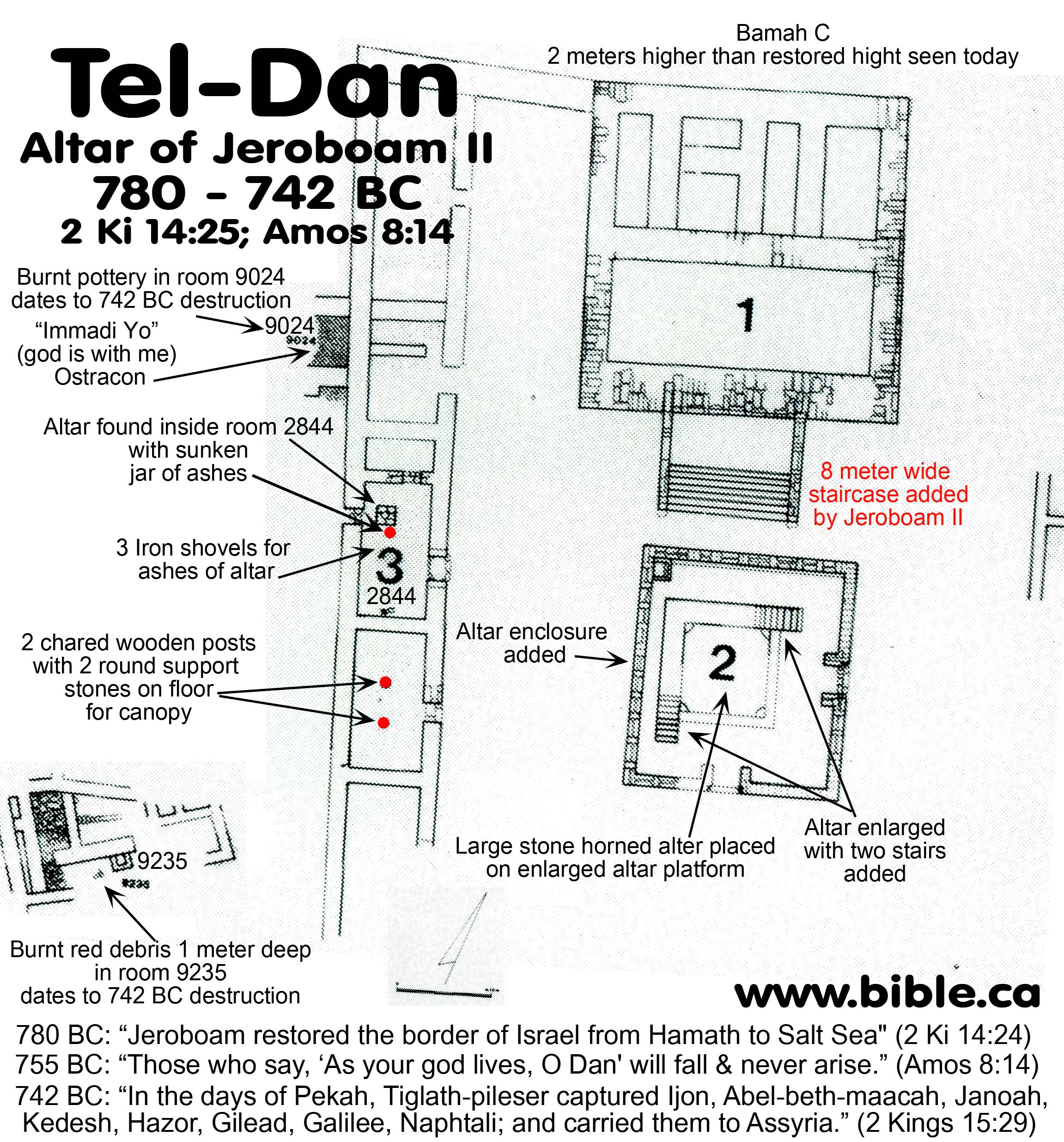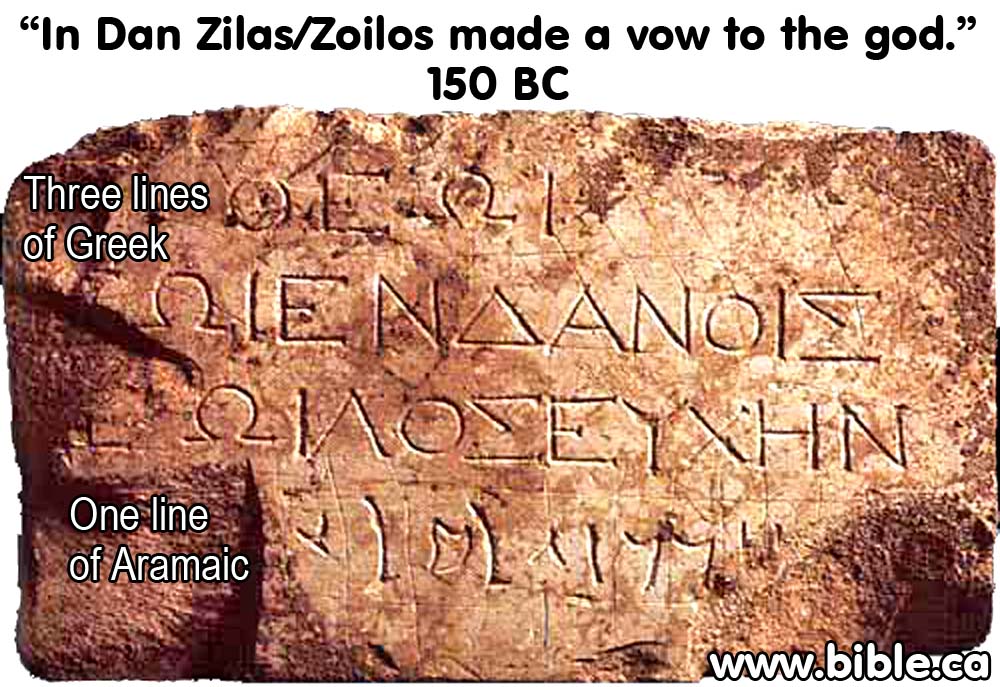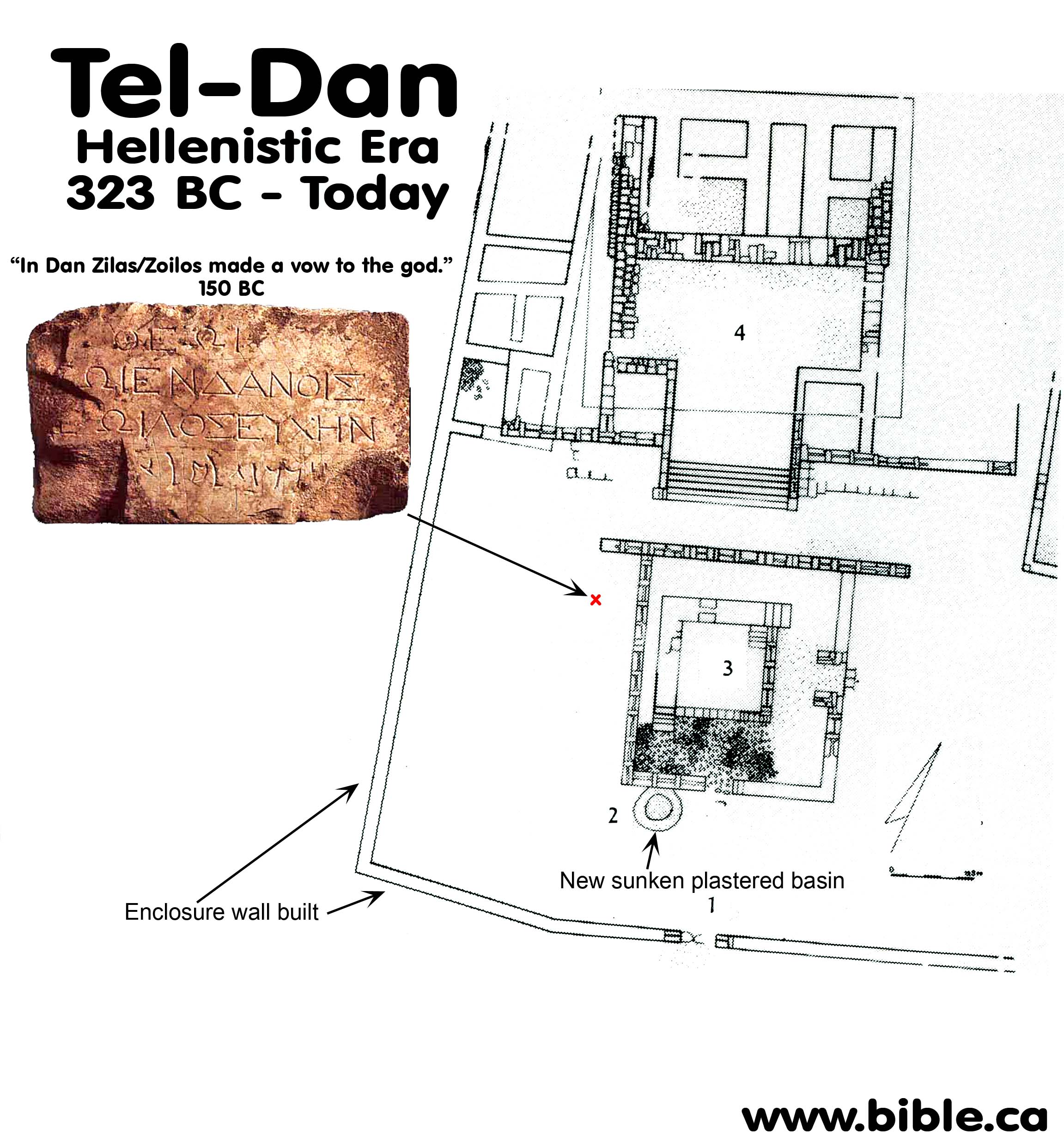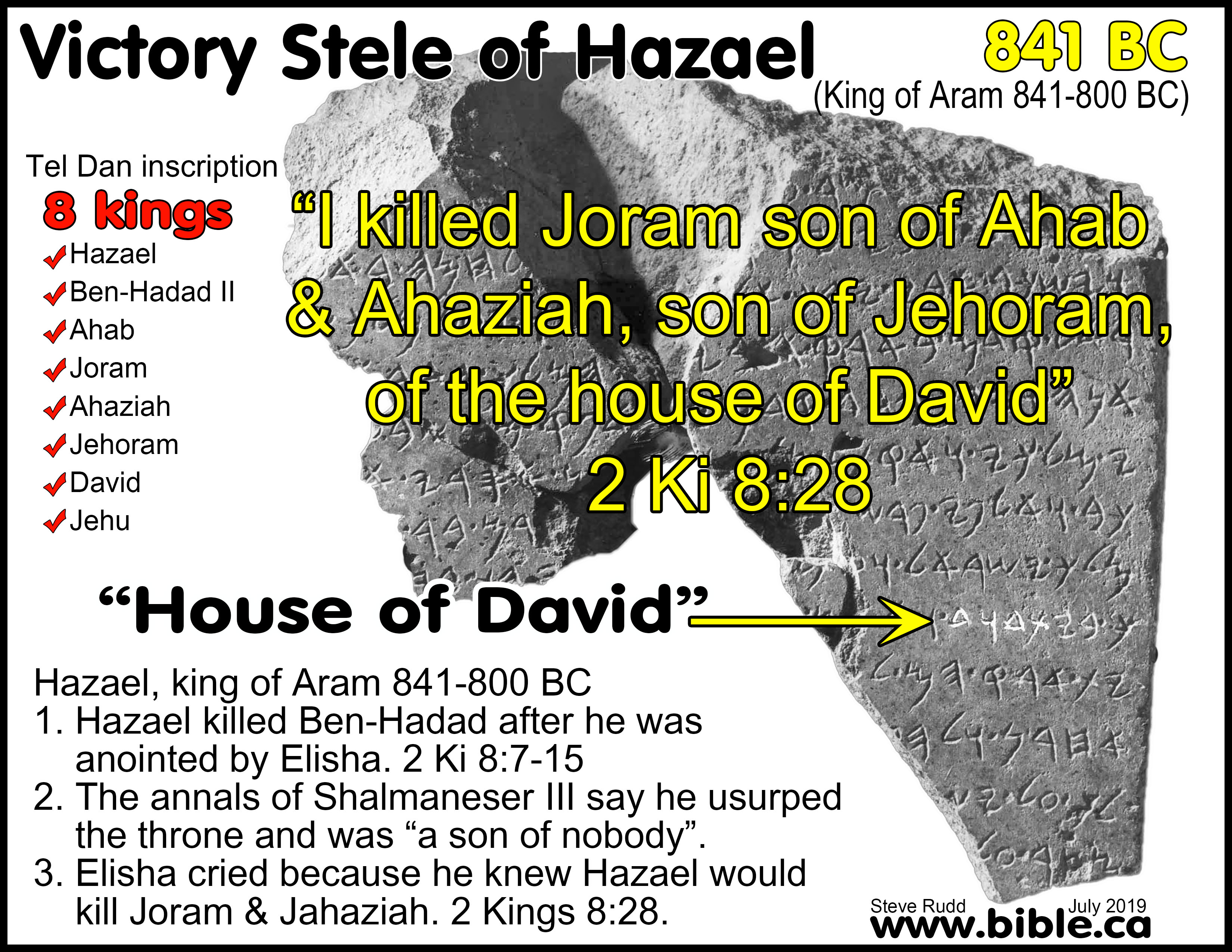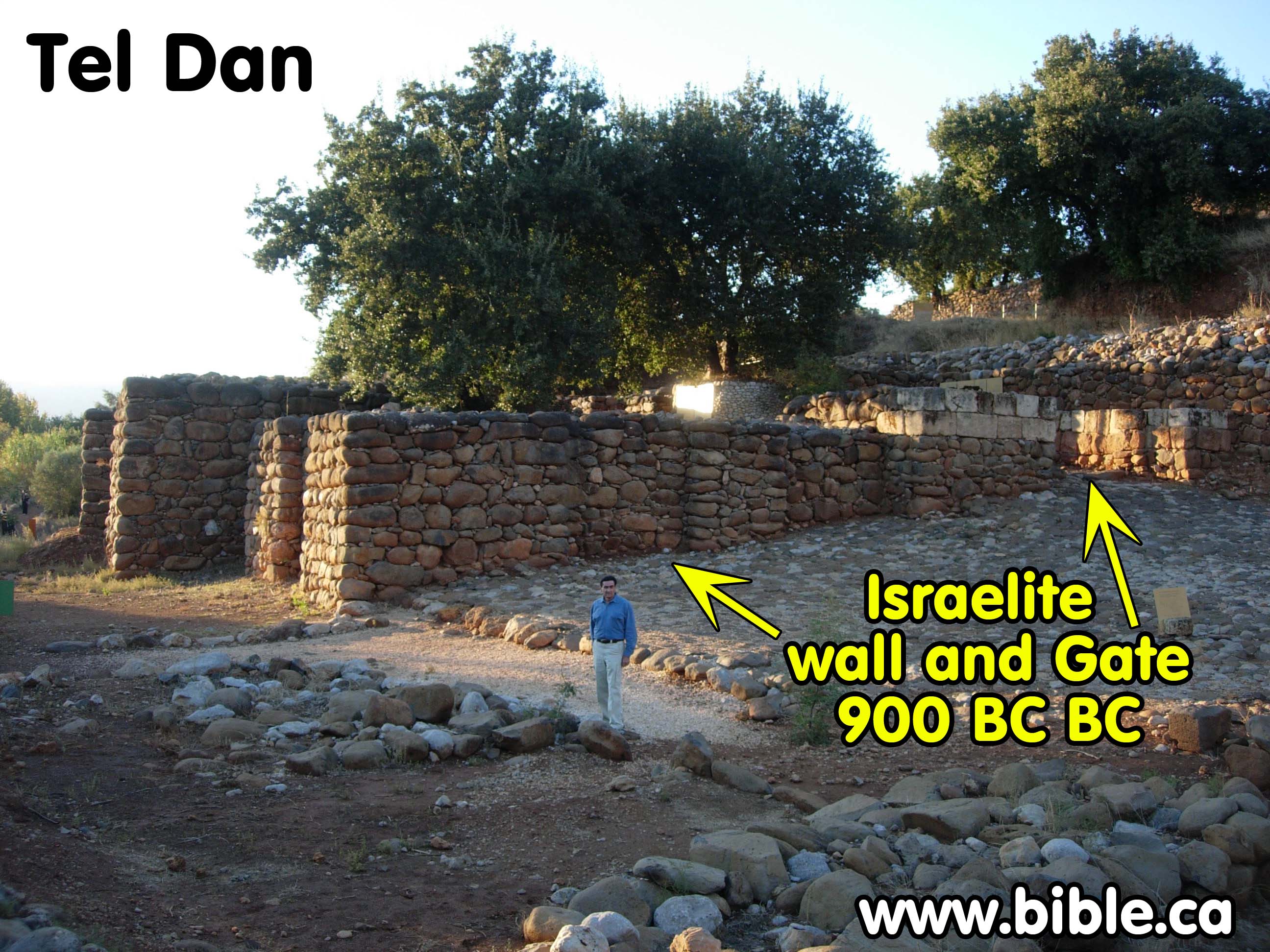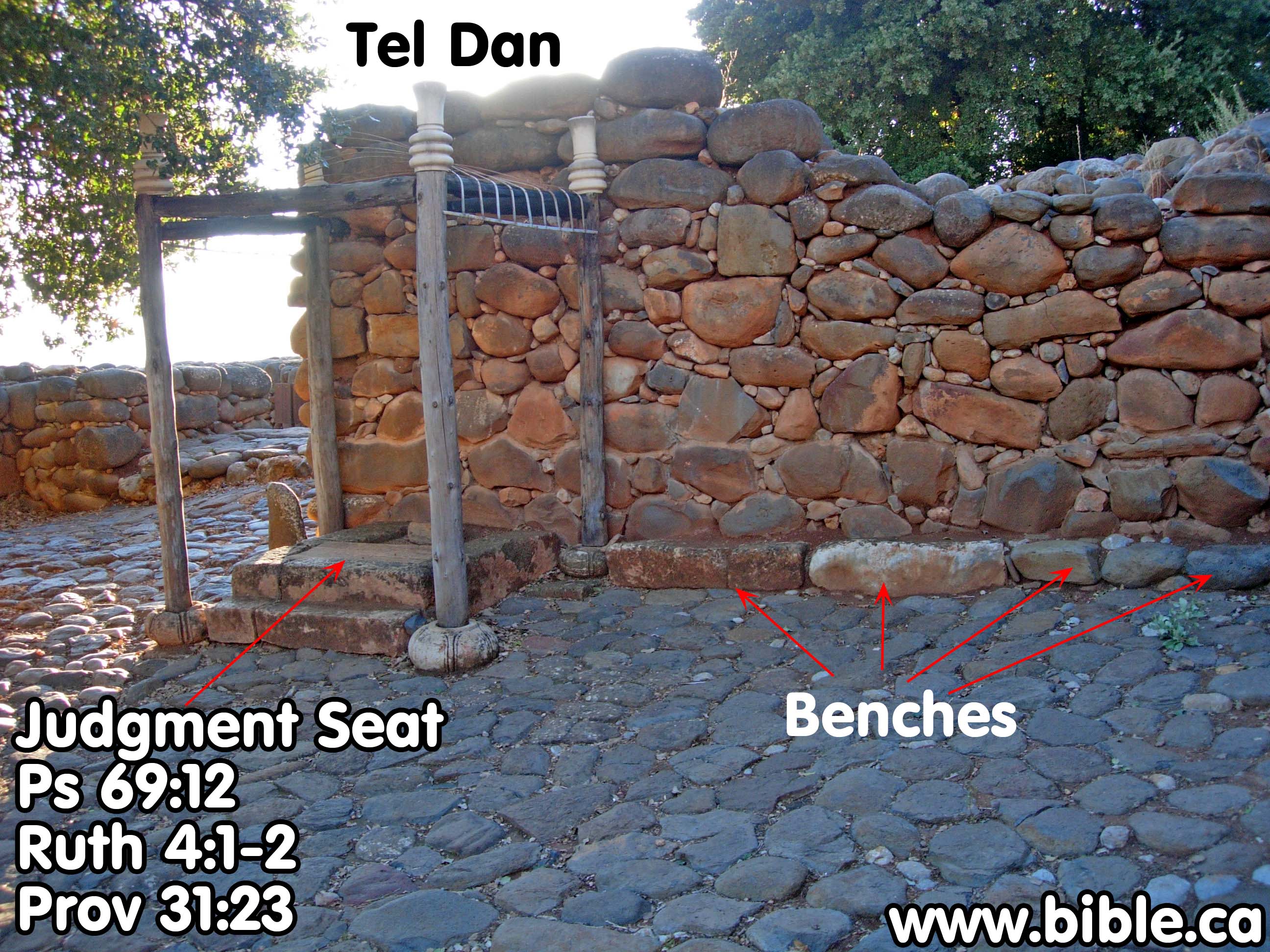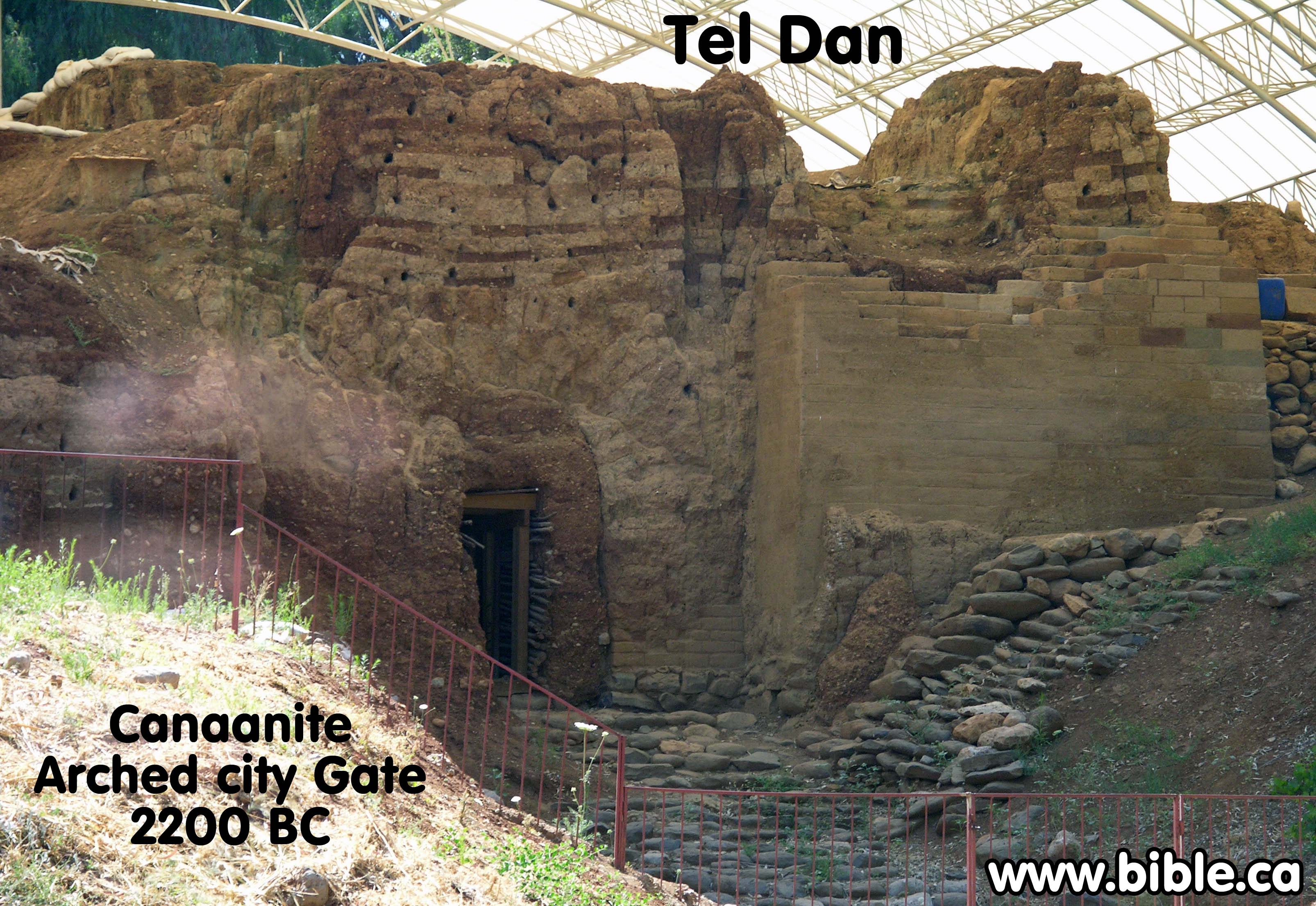Jeroboam, King of Israel 931-910 BC
Divided Kingdom Period: Israel: 931-723 BC; Judah: 931-587 BC
The Satan King who sowed "Tares"
Jeroboams Danite Pagan altar and high place: 1340-723 BC
· "Dan shall judge (test) his people (through their idolatry), as one of the tribes of Israel. Dan shall be a serpent in the way, a horned snake in the path, That bites the horse's heels, So that his rider falls backward (in 722 BC). For Your salvation I wait, O Lord." (Genesis 49:16-18
· "The sons of Dan set up for themselves the graven image; and Jonathan, the son of Gershom, the son of Moses, he and his sons were priests to the tribe of the Danites until the day of the captivity of the land." (Judges 18:30)
· “When God had torn Israel from the house of David, they made Jeroboam the son of Nebat king. Then Jeroboam drove Israel away from following the Lord and made them commit a great sin. The sons of Israel walked in all the sins of Jeroboam which he did; they did not depart from them until the Lord removed Israel from His sight, as He spoke through all His servants the prophets. So Israel was carried away into exile from their own land to Assyria until this day.” (2 Kings 17:21-23)
|
|
||
|
Contrary to popular opinion, Jeroboam was merely a side-show and a "Johnny-come-lately", in the idolatry at tel Dan. It all started hundreds of years before he was born in 1340 BC when Micah's idolatry was transplanted to Dan (Judges 17-19) and the Jonathan, the grandson of Moses founded a dynastic pagan priesthood which endured until the tribe of Dan went extinct in 723 BC. (Judges 18:30) So evil was the tribe of Dan in leading all Israel into idol worship, that they are not listed as one of the 12 tribes in heaven in the book of Revelation. |
||
|
Archaeologists are digging up bible stories!!! |
||
|
Archaeology is an important science that confirms the historical accuracy of the Bible. Since the Bible refers to hundreds of cities, kings, and places, we would expect to find evidence from on-site excavations. And this is exactly what we have found. The Bible is the most historically accurate book of history on earth. Read the Bible daily! |
|
|
Jeroboam, King of Israel 931-910 BC
Divided Kingdom Period: Israel: 931-723 BC; Judah: 931-587 BC
The Satan King who sowed "Tares"
See also:
1. Hazael Victory Stele with the "House of David" inscription.
2. Headwaters of Jordan River water system began at Tel Dan
3. Book of Ruth: Ruth and Boaz lived in the time of Ehud: 1300 BC
4. Harmony of Othneil, Ehud, Judges 17-18, Judges 19-21 and Ruth
5. Chronology of the book of Judges solved
Introduction:
1. Jeroboam is painted in the Bible as the Satan child in leading all Israel into spiritual harlotry, but as we will see, he is not the primary culprit.
a. Granted, there are no less than 13 other kings of Israel, whose idolatry is traced back to Jeroboam. (see below)
- After Assyrian deportation of 723 BC: “When He had torn Israel from the house of David, they made Jeroboam the son of Nebat king. Then Jeroboam drove Israel away from following the Lord and made them commit a great sin. The sons of Israel walked in all the sins of Jeroboam which he did; they did not depart from them until the Lord removed Israel from His sight, as He spoke through all His servants the prophets. So Israel was carried away into exile from their own land to Assyria until this day.” (2 Kings 17:21–23)
2. Contrary to popular opinion, Jeroboam was merely a side-show and a "Johnny-come-lately", in the idolatry at tel Dan. It all started hundreds of years before he was born in 1340 BC when Micah's idolatry was transplanted to Dan (Judges 17-19) and the Jonathan, the grandson of Moses founded a dynastic pagan priesthood which endured until the tribe of Dan went extinct in 723 BC. (Judges 18:30) So evil was the tribe of Dan in leading all Israel into idol worship, that they are not listed as one of the 12 tribes in heaven in the book of Revelation.
3. You start with a boy named Micah, who steals silver from his mother. His mother uses this stolen silver to build her son a pagan shrine, complete with ephod. The faithless tribe of Dan were unwilling to fight the Philistines who inhabited most of the land, so they travelled north and conquered an undefended and complacent city called Laish/Leshem and renamed it Dan. However, as they travelled north, they stole Micah's pagan shrine and Jonathan agreed to be the chief priest for the tribe of Dan, "Is it better for you to be a priest to the house of one man, or to be priest to a tribe and a family in Israel?” (Judges 18:19). In the a dynasty of priests (father/son/son etc.) that lasted 716 years (1340-723 BC) these pagan priests corrupted not only the tribe of Dan, but eventually, through the power of King Jeroboam, all 10 tribes of Israel who went into extinction and exile. And it all started from a thief named Micah. Had Micah's mother carried through with her curse, it would have saved the millions of the 10 tribes from the curse of God! “He said to his mother, “The eleven hundred pieces of silver which were taken from you, about which you uttered a curse in my hearing, behold, the silver is with me; I took it.” And his mother said, “Blessed be my son by the Lord.”” (Judges 17:2)
- Although Jeroboam was anointed king over the 10 northern tribes "Israel" by the prophet Ahijah in 1 Kings 11:29, no king in Hebrew history caused more spiritual destruction to the people of God than Jeroboam.
- It is quite likely that Jeroboam used the pagan shrine of the Danites as a template upon which to build his new religion.
- Jeroboam turned the monotheistic worship of YHWH into his own system of polytheism that included the worship of many pagan gods, most notably, the Golden Calf Israel worshipped at Mt. Sinai during the exodus.
- Jeroboam joins others in history who singlehandedly invented a new religion:
i. Akhenaten and Muhammad turned a pagan polytheism into a pagan monotheism through force conversion.
ii. Buddha invented one of many eastern spiritual mystic self-enlightenment religions.
- Motivated by political self-interest and worry about losing his kingdom to Rehoboam, son of Solomon, he invented a "look alike" religion of "Tares" (Mt 13:24-30) that retained the feel of YHWH worship but was in fact a satanic substitution.
i. “Yet Jeroboam the son of Nebat, the servant of Solomon the son of David, rose up and rebelled against his master, and worthless men gathered about him, scoundrels, who proved too strong for Rehoboam, the son of Solomon, when he was young and timid and could not hold his own against them. “So now you intend to resist the kingdom of the Lord through the sons of David, being a great multitude and having with you the golden calves which Jeroboam made for gods for you. “Have you not driven out the priests of the Lord, the sons of Aaron and the Levites, and made for yourselves priests like the peoples of other lands? Whoever comes to consecrate himself with a young bull and seven rams, even he may become a priest of what are no gods.” (2 Chronicles 13:6–9)
- Scripture specifically says the religion was something he "devised in his own heart": “Then he went up to the altar which he had made in Bethel on the fifteenth day in the eighth month, even in the month which he had devised in his own heart; and he instituted a feast for the sons of Israel and went up to the altar to burn incense.” (1 Kings 12:33)
- While every single kings of Israel was wicked WITHOUT EXCEPTION, scripture always points out the cause and effect, which traces itself directly back to Jeroboam.
- Baasha: “He did evil in the sight of the Lord, and walked in the way of Jeroboam and in his sin which he made Israel sin.” (1 Kings 15:34) “Inasmuch as I exalted you from the dust and made you leader over My people Israel, and you have walked in the way of Jeroboam and have made My people Israel sin, provoking Me to anger with their sins, behold, I will consume Baasha and his house, and I will make your house like the house of Jeroboam the son of Nebat.” (1 Kings 16:2–3)
- Zimri: “When Zimri saw that the city was taken, he went into the citadel of the king’s house and burned the king’s house over him with fire, and died, because of his sins which he sinned, doing evil in the sight of the Lord, walking in the way of Jeroboam, and in his sin which he did, making Israel sin.” (1 Kings 16:18–19)
- Omri: “Omri did evil in the sight of the Lord, and acted more wickedly than all who were before him. For he walked in all the way of Jeroboam the son of Nebat and in his sins which he made Israel sin, provoking the Lord God of Israel with their idols.” (1 Kings 16:25–26)
- Ahab: “Ahab the son of Omri did evil in the sight of the Lord more than all who were before him. It came about, as though it had been a trivial thing for him to walk in the sins of Jeroboam the son of Nebat, that he married Jezebel the daughter of Ethbaal king of the Sidonians, and went to serve Baal and worshiped him.” (1 Kings 16:30–31) ““Behold, I will bring evil upon you, and will utterly sweep you away, and will cut off from Ahab every male, both bond and free in Israel; and I will make your house like the house of Jeroboam the son of Nebat, and like the house of Baasha the son of Ahijah, because of the provocation with which you have provoked Me to anger, and because you have made Israel sin.” (1 Kings 21:21–22)
- Ahaziah: “He did evil in the sight of the Lord and walked in the way of his father and in the way of his mother and in the way of Jeroboam the son of Nebat, who caused Israel to sin. So he served Baal and worshiped him and provoked the Lord God of Israel to anger, according to all that his father had done.” (1 Kings 22:52–53)
- Jehoram: “He did evil in the sight of the Lord, though not like his father and his mother; for he put away the sacred pillar of Baal which his father had made. Nevertheless, he clung to the sins of Jeroboam the son of Nebat, which he made Israel sin; he did not depart from them.” (2 Kings 3:2–3)
- Jehu: “Thus Jehu eradicated Baal out of Israel. However, as for the sins of Jeroboam the son of Nebat, which he made Israel sin, from these Jehu did not depart, even the golden calves that were at Bethel and that were at Dan. … But Jehu was not careful to walk in the law of the Lord, the God of Israel, with all his heart; he did not depart from the sins of Jeroboam, which he made Israel sin.” (2 Kings 10:28-29, 31)
- Jehoahaz: “He did evil in the sight of the Lord, and followed the sins of Jeroboam the son of Nebat, with which he made Israel sin; he did not turn from them. … Nevertheless they did not turn away from the sins of the house of Jeroboam, with which he made Israel sin, but walked in them; and the Asherah also remained standing in Samaria.” (2 Kings 13:2,6)
- Jehoash: “He did evil in the sight of the Lord; he did not turn away from all the sins of Jeroboam the son of Nebat, with which he made Israel sin, but he walked in them.” (2 Kings 13:11)
- Jeroboam II: “In the fifteenth year of Amaziah the son of Joash king of Judah, Jeroboam the son of Joash king of Israel became king in Samaria, and reigned forty-one years. He did evil in the sight of the Lord; he did not depart from all the sins of Jeroboam the son of Nebat, which he made Israel sin.” (2 Kings 14:23-24)
- Zechariah: “He did evil in the sight of the Lord, as his fathers had done; he did not depart from the sins of Jeroboam the son of Nebat, which he made Israel sin.” (2 Kings 15:9)
- Menahem: “He did evil in the sight of the Lord; he did not depart all his days from the sins of Jeroboam the son of Nebat, which he made Israel sin.” (2 Kings 15:18)
- Pekahiah: “He did evil in the sight of the Lord; he did not depart from the sins of Jeroboam son of Nebat, which he made Israel sin.” (2 Kings 15:24)
- Epilogue after Assyrian deportation of 723 BC: “When He had torn Israel from the house of David, they made Jeroboam the son of Nebat king. Then Jeroboam drove Israel away from following the Lord and made them commit a great sin. The sons of Israel walked in all the sins of Jeroboam which he did; they did not depart from them until the Lord removed Israel from His sight, as He spoke through all His servants the prophets. So Israel was carried away into exile from their own land to Assyria until this day.” (2 Kings 17:21–23)
I. Overview of the Pagan Altar High Place at Tel Dan:
- "The Sacred Area or temenos at Dan is a large complex over a half-acre in size. The central open-air platform of the Sacred Area went through three phases during the Israelite period. Biran has identified the three phases of the platform as Bamah A of Jeroboam 931 BC, Bamah B Ahab 874-853 BC, and Bamah C of Jeroboam II 780-742 BC . In any event it is clear that this entire area at Tel Dan was an important Israelite cultic center. Whether it is the beth bamoth referred to in 1 Kings 12:31, as Biran believes, will no doubt continue to be debated by scholars for years to come. Although the Biblical record is silent concerning the specific cultic acts performed at Dan and does not even specify what use was made of the Golden Calf which Jeroboam made, the archaeological evidence suggests that a large, open-air platform was used, that there were altars, incense offerings, votive offerings involving figurines, and some kind of water purification or libation rituals." (The Remarkable Discoveries at Tel Dan, John C. H. Laughlin, BAR 07:05, 1981)
- "The Bamah or High Place: In 1968 a large structure of the Israelite period was uncovered on the north-western part of the mound (Area T). The fine masonry, laid in headers and stretchers, resembles the monumental Israelite constructions found in Samaria and Megiddo. Subsequent excavations led us to the conclusion that we have here a bamah, or High Place, possibly an open air sanctuary. In the center of the excavated area an almost square structure was revealed, measuring 18.2 by 18.7 m. (roughly 60 by 62 feet) the outer walls of which were of dressed limestone (Fig. 11 ) with the exception of the northern side which was built in part of large basalt blocks. The width of the walls varied between 1.5 m. and 2.3 m. (five and seven feet). The building method was uniform—the lower two courses were of headers while the upper courses were laid in alternating headers and stretchers (Fig. 12 ). All the stones were dressed in the style characteristic of the period of the Israelite monarchy. The space enclosed by the four walls was filled with basalt stones, forming a wide, flat platform. On the southern edge of the bamah, facing the town, a monumental flight of steps eight meters, or twenty-seven feet, wide was uncovered, built directly against the outer wall of the bamah (Fig. 13 ); this stairway is in part superimposed over the earlier masonry. Pottery collected from the steps points to a date in the mid-9th century B.C. A number of soundings carried out on the bamah, as well as remains of an earlier flight of steps apparently built before the construction of the ramparts, indicate that some structure, perhaps of a cult nature, existed here already in the Middle Bronze II age. In the Israelite period, the bamah had two stages. The first stage may be correlated with the reign of Jeroboam I: “And he made houses on high places, and appointed priests of the lowest of the people, who were not of the Levites,” (I Kings 12:31). A burnt layer, which covered the lower ashlars, contained pottery of the 10th century B.C. The area of the first Israelite bamah is tentatively estimated to be 6 by 18.4 m. (twenty by sixty-one feet). Of the second stage, the four corners of the bamah were preserved in addition to the square platform. No evidence of the destruction of this bamah could be traced. The monumental steps belong to the second stage in the building of the bamah. A sounding under the steps revealed pottery from the mid-9th century B.C. Thus, this second stage could be attributed to Ahab, who defeated the Arameans in the battle of Aphek: “And Ben-Hadad said to him, ‘The cities which my father took from your father, I will restore; and you shall make streets for yourself in Damascus…’” (I Kings 20:34). It should be assumed that in order to strengthen his lines of communications with Damascus, Ahab had to fortify Dan as well (I Kings 22:39). No doubt Ahab also devoted himself to the worship of the golden calf: “And Ahab did more to provoke the Lord God of Israel to anger than all the kings of Israel that were before him” (I Kings 16:33). To that period (Iron II) belong the head of a female clay figure and seven-spouted oil lamps (Fig. 14 ). In the 8th and 7th centuries B.C., perhaps after the Assyrian conquest, there was extensive rebuilding, and walls and structures were erected. The cult tradition was not forgotten in the following centuries, or even as late as the Hellenistic and Roman periods, when the area of the bamah was further enlarged by extending the enclosure. The marble statue of Aphrodite found in the fields near the mound (Fig. 15 ) may well have been located originally at the site of our bamah." (Tel Dan, Avram Biran, Biblical Archaeologist, vol 37, 1974 AD)
- "If this were the only shrine at Dan, it would still be remarkable. Yet we have found a number of other religious installations at Dan during 31 years of digging, the longest-running excavation in all of Israel. (Why have so many shrines been found here? If other sites in Israel were as extensively excavated, would they too yield as many shrines?) The bamah just described is located well inside the city. Several others are clustered around the city’s gate complex." (Sacred Spaces: Of standing stones, high places and cult objects at Tel Dan, Avraham Biran, BAR 24:05, 1998 AD)
II. Exposition of Judges 17-18: How money a boy stole from his mother led to the destruction of ten tribes in 723 BC
- Pagan prehistory of tel-Dan before Jeroboam: 1340 - 931 BC.
- While it is clear Jeroboam set up an altar at Bethel and Dan, most Bible students fail to realize that he inherited and modified the pagan altar at Dan that had functioned for 420 continuous years before him.
- The archeology at tel Dan (Laish) provides us with an incredible window into the ancient pagan history of the tribe of Dan in 1350 BC and Jeroboam in 930 BC.
- Judges chapters 17-18 details how the faithless tribe of Dan was unable to take over the land granted to them by Joshua so they moved en-mass north and invaded the city of Laish which had no fortification or military, but lived in blissful and ignorant comfort similar to many European nations today.
- Micah was an Ephraimite who created his own pagan shrine who hired a Bethlehemite Levite priest named Jonathan to be in charge.
- “They called the name of the city Dan, after the name of Dan their father who was born in Israel; however, the name of the city formerly was Laish. The sons of Dan set up for themselves the graven image; and Jonathan, the son of Gershom, the son of Manasseh, he and his sons were priests to the tribe of the Danites until the day of the captivity of the land. So they set up for themselves Micah’s graven image which he had made, all the time that the house of God was at Shiloh.” (Judges 18:29-31)
- The Danites set up Micah's idol first at Shiloh from about 1350 - 1088 BC, until the Philistines captured the ark.
i. It appears that initially, Micah's idol was set up at tel-Dan.
ii. Shiloh is in the tribe of Ephraim and this may be why the main idol of Micah (an Ephraimite) was later moved there.
- When Jeroboam chose to set up an idol at Bethel and Dan, he essentially inherited the dynastic priesthood of Jonathan that continued to exist until the Assyrian captivity of 723 BC.
i. The Bethel sanctuary of Jeroboam existed until Josiah destroyed it in 621 BC.
ii. “Furthermore, the altar that was at Bethel and the high place which Jeroboam the son of Nebat, who made Israel sin, had made, even that altar and the high place he broke down. Then he demolished its stones, ground them to dust, and burned the Asherah.” (2 Kings 23:15)
iii. Both golden calf idols still existed in the time of Jehu (814-841 BC): “Thus Jehu eradicated Baal out of Israel. However, as for the sins of Jeroboam the son of Nebat, which he made Israel sin, from these Jehu did not depart, even the golden calves that were at Bethel and that were at Dan.” (2 Kings 10:28–29)
iv. Jeroboam's Bethel Altar was finally destroyed by Josiah in 621 BC: “Furthermore, the altar that was at Bethel and the high place which Jeroboam the son of Nebat, who made Israel sin, had made, even that altar and the high place he broke down. Then he demolished its stones, ground them to dust, and burned the Asherah. Now when Josiah turned, he saw the graves that were there on the mountain, and he sent and took the bones from the graves and burned them on the altar and defiled it according to the word of the Lord which the man of God proclaimed, who proclaimed these things.” (2 Kings 23:15–16)
- Micah's idolatry brought nothing but destruction:
i. In 1088 BC, Micah's idolatry brought about the extinction of the priesthood of Eli and the destruction of Shiloh as the location of the Mosaic tent of meeting which was moved to Nob.
ii. In 930 BC, Micah's idolatry was inherited and modified by Jeroboam who continued to use Jonathan's sons at tel-Dan for his new religion.
iii. All the males of house of Jeroboam were killed: “therefore behold, I am bringing calamity on the house of Jeroboam, and will cut off from Jeroboam every male person [lit: him who urinates against the wall], both bond and free in Israel, and I will make a clean sweep of the house of Jeroboam, as one sweeps away dung until it is all gone.” (1 Kings 14:10)
iv. In 723 BC, Jeroboams modification of Micah's idolatry brought about the extinction of the 10 northern tribes of Israel.
v. In Revelation 7:4-8, the tribes of Ephraim and Dan are not included in the list of 12 tribes that make up the 144,000 because of the capital crime of being the two most influential driving forces of idol worship in Israel's history.
2. Judges 17:1-6: The story opens with a man named Micah in the hill country of Ephraim, confessing to his mother that he stole the 1100 pieces of silver that she had been looking for.
a. 1100 pieces of silver is a huge sum of money and is equal to what each of the five Philistine kings promised Delilah to betray Samson. (16:5) She was promised a total of 5500 pieces of silver.
b. She had uttered a curse and her son, confessed in order to escape the curse. His confession was motived out of fear of punishment, not morality and doing what is right.
c. The mother strangely rewards the delinquent son by giving him all the money to make an idol in the name of YHWH.
d. She overlooks the fact that her son is guilty of breaking several of the Ten Commandments including stealing and honouring your father and mother, coveting etc, then praises him in the name of YHWH and orders him to break the second commandment regarding graven images.
e. In the second commandment is contained a warning against CARVING or MOULDING and idol. "You shall not make for yourself an idol (literally carved image), or any likeness (literally poured from a form) of what is in heaven above or on the earth beneath or in the water under the earth." (Exodus 20:4)
f. The mother orders her son to explicitly break both elements of the second commandment: "I wholly dedicate the silver from my hand to the LORD for my son to make a GRAVEN image and a MOLTEN image; now therefore, I will return them to you." (Judges 17:3)
g. There are no bad kids, only bad parents so ultimately, the extinction of the ten lost tribes in 723 BC can be traced through Jeroboam in 924 BC back to the tribe of Dan in 1340 BC and ultimately back to this bad mother who orders her son to further break the ten commandments rather than discipline him.
h. Ephraim's contribution to the extinction of the ten tribes in 723BC, is Micah who turns stolen silver into an Idol, an Ephod and a shrine. Judah's contribution, as we will see, is the delusion that just because a Levite priest thinks all this idolatry is ok, that God will bless you.
3. Judges 17:7-13 Enter Jonathan, the Bethlehemite priest, with blood lines in the tribe of Judah, who travels north to Ephraim in search of a job as a priest.
a. He accepts the offer to become the family Levite priest of Micah's idolatry.
b. Micah is now confident God will bless him when the Jonathan fails to criticize the idol but instead rubber stamps it.
c. Jonathan fails in his most basic duty as a priest of YHWH by presiding over a pagan shrine and it can all be traced back to his mother who orders him to make the shrine.
4. Judges 18:1-31 The tribe of Dan seeks a larger territory
a. Through lack of faith in God, Dan is unable to defeat the Philistines who control 75% of their inheritance and they are forced to live in the hill country.
b. After Othniel delivers Israel from the oppression of king of Mesopatamia (Judges 3:9-11) the tribe of Dan decides to send scouts up north to find new land.
c. As the spied move north, they come to the house of Micah and recognize Jonathan, whom they knew when he lived in or near Bethlehem. They ask him for a blessing and they are granted success from YHWH.
d. The spies view Laish (city of Dan) and return with confidence that they can defeat the inhabitants.
e. As a portion of the tribe of Dan migrate north, they again come to the house of Micah and steal the silver idol, ephod and shrine and offer Jonathan the Levite, a promotion from being a priest of a single family to the top priest for the entire tribe. Money and pride motivate Jonathan, of course accepts.
f. While Micah feels robbed of his idolatrous religion of silver, it was in fact a blessing that this curse was removed from him so he could worship YHWH correctly.
5. The story concludes with the ominous observation that the pagan idolatry of Micah continued from the moment Dan arrived in Laish (Dan) to the time of the Assyrian captivity of 723 BC.
a. "The sons of Dan set up for themselves the graven image; and Jonathan, the son of Gershom, the son of Manasseh, he and his sons were priests to the tribe of the Danites until the day of the captivity of the land. So they set up for themselves Micah's graven image which he had made, all the time that the house of God was at Shiloh." (Judges 18:30-31)
b. All the while God's true religion was centered in Shiloh where the tabernacle of Moses and the Ark of the Covenant resided.
6. The reader in 700 BC would understand the origin of the idolatry of Jeroboam that led to the extinction of the ten lost tribes. An Ephraimite family creates a pagan shrine, and the Judean Levite grandson of Moses thinks this is all ok and becomes the priest of this family shrine. Then the tribe of Dan, whose lack of faith is measured by their failure to trust God to attack the well-defended warrior Philistines and instead chose the unprotected sitting duck, Laish, where they could act all brave. Dan transports this pagan shrine from Ephraim to Laish, where it continued, with a few modifications from Jeroboam in 924 BC, until captivity of 723 BC.
7. Now the reader in 720 BC knows the exact history of where the paganism had its origin: A bad mother, a thieving son, a material motivated priest and the faithless tribe of Dan.
8. The story of Judges 17-18 happened in 1340 BC.
III. God chose and anointed Jeroboam as King to replace Solomon
- For all the evil Jeroboam caused Israel, he was initially chosen by God to be king.
- This was in retaliation to Solomon's rampant idolatry.
- The prophet Ahijah told Jeroboam he was the God anointed King of 10 tribes:
i. “Then Ahijah took hold of the new cloak which was on him and tore it into twelve pieces. He said to Jeroboam, “Take for yourself ten pieces; for thus says the Lord, the God of Israel, ‘Behold, I will tear the kingdom out of the hand of Solomon and give you ten tribes (but he will have one tribe, for the sake of My servant David and for the sake of Jerusalem, the city which I have chosen from all the tribes of Israel), because they have forsaken Me, and have worshiped Ashtoreth the goddess of the Sidonians, Chemosh the god of Moab, and Milcom the god of the sons of Ammon; and they have not walked in My ways, doing what is right in My sight and observing My statutes and My ordinances, as his father David did.” (1 Kings 11:30–33)
- When Solomon learned that Jeroboam would divide the kingdom and get 10 tribes, Jeroboam fled to Egypt and was "called out of Egypt" home to Shechem.
- There is some kind of meaning to God calling his anointed or chosen out of Egypt. Clearly the prophecy of Hosea being applied to Jesus in Mt 2:14-15 is noteworthy. Perhaps only after the second coming will we learn historical details before the world was created as to why this is important. Perhaps the angels understand the antitypical importance.
i. Abraham fled to Egypt and returned to Ai to be given the promised land.
ii. Israel was called out of Egypt during the exodus: “When Israel was a youth I loved him, And out of Egypt I called My son.” (Hosea 11:1)
iii. Jeroboam was called out of Egypt by the ten tribes to be king.
iv. Jesus was called out of Egypt: “So Joseph got up and took the Child and His mother while it was still night, and left for Egypt. He remained there until the death of Herod. This was to fulfill what had been spoken by the Lord through the prophet: “Out of Egypt I called My Son.”” (Matthew 2:14–15)
- TEXT OF 1 Kings 12:24:a-z: as it is known in the Septuagint, is a huge gloss/addition in it that the Masoretic text of most Bibles. This translation is from "The Lexham English Septuagint., Brannan, R., Penner, K. M., Loken, I., Aubrey, M., & Hoogendyk, 1 Kings 12:24:a-z, 2012 AD".
a. 24a And King Solomon slept with his fathers, and he was buried with his fathers in the city of David. And Rehoboam his son reigned in place of him in Jerusalem, being sixteen years old when he began to reign, and twelve years he reigned in Jerusalem, and the name of his mother was Naanan the daughter of Hanan the son of Nahash king of Ammon. And he did what was evil before the Lord, and he did not go in the way of David his father.
b. 24b And there was a man from the mountain of Ephraim, a servant of Solomon, and his name was Jeroboam, and the name of his mother was Sarisa, a prostitute. And Solomon made him into chief of staff over the forced labor of the house to Joseph, and he built for Solomon Sarira, which is in the mountain of Ephraim, and there were to him three hundred horse-drawn chariots. This one built the citadel with the forced labor of the house of Ephraim, this one closed off the city of David, and he was exalted over the kingdom.
c. 24c And Solomon was trying to put him to death, and he was afraid and he fled to Shishak king of Egypt, and he was with him until Solomon died.
d. 24d And Jeroboam heard in Egypt that Solomon was dead. And he spoke into the ears of Shishak king of Egypt, saying, “Send me away, and I will depart to my land.” And Shishak said to him, “Ask any request, and I will give it to you.”
e. 24e And Shishak gave Jeroboam Ano the elder sister of Tahpenes his own wife to him for a wife. This one is great in the midst of the daughters of the king. And she bore for Jeroboam Abijah his son.
f. 24f And Jeroboam said to Shishak, “Send me out truly, and I will depart.” And Jeroboam came out from Egypt, and he came to the land of Sarira, which was in the mountain of Ephraim, and all the staffs of Ephraim were gathered together there, and Jeroboam built bulwarks there.
g. 24g And his child became sick ⌊with an exceedingly bad sickness⌋, and Jeroboam went to inquire concerning the child, and he said to Ano his wife, “Arise, go inquire of God concerning the child if he will live from his sickness.”
h. 24h And there was a man in Shiloh, and the name to him was Ahijah, and this one was sixty years old, and the word of the Lord was with him. And Jeroboam said to his wife, “Arise, and take into your hand for the man of God bread and cake for his children and grapes and a pot of honey.”
i. 24i And the woman arose and took into her hand bread and two cakes and grapes and a pot of honey to Ahijah. And the man was old, and his eyes became dim-sighted for seeing.
j. 24k And she arose from Sarira and she went, and it happened as she was coming into the city to Ahijah the Selonite, and Ahijah said to his servant, “Go out indeed for a meeting with Ano the wife of Jeroboam, and you shall say to her, ‘Enter and do not stand in position because the Lord says this, “I send harsh things upon you.” ’ ”
k. 24l And Ano entered to the man of God with cakes and a pot of honey. The Lord says this, “Behold, you will depart from me, and it will be when you entered the gate into Sarira and your maidservants will come out to you for a meeting, and they will say to you, ‘The child is dead.’
l. 24m Because the Lord says this, ‘Behold, I will utterly destroy those who urinate towards the wall of a house who belong to Jeroboam, and it will be the ones who died in the city who belong to Jeroboam, the dogs will devour, and the one who died in the field the birds of the sky will devour. And he will strike the child.’ Alas, Lord, for a good word was found in him concerning the Lord.”
m. 24n And the woman went out when she heard, and it happened when she entered into Sarira, and the child died, and the cry went out to meet her. And Jeroboam went to Shechem, which was in the mountain of Ephraim, and he gathered together there the tribes of Israel, and Rehoboam son of Solomon went up from there.
n. 24o And the word of the Lord came to Shemaiah the Elamite, saying, “Take for yourself a new garment that has not entered into water and tear it into twelve pieces, and you will give them to Jeroboam, and you shall say to him, ‘The Lord says this, “Take for yourself twelve pieces to throw round you.” ’ ” And Jeroboam took them, and Shemaiah said, “The Lord says this concerning the ten tribes of Israel.”
o. 24p And the people said to Rehoboam son of Solomon, “Your father made heavy his yoke upon us, and he made heavy the food of his table. And now you made it easier on us, we will serve you.” And Rehoboam said to the people, “There are still three days and I will reply a word to you.”
p. 24q And Rehoboam said, “Bring me the elders and I will take counsel with them, what word I answer the people on the third day.” And Rehoboam spoke into their ears just as the people sent to him, and the elders of the people said, “Thus the people spoke to you.”
q. 24r And Rehoboam rejected their counsel, and it was not pleasing before him, and he sent and brought in his comrades, and he spoke to them the same things, “And these things the people sent to me, saying.” And his comrades said, “Thus you will speak to the people, saying, ‘My smallness is thicker than the loins of my father; my father chastised you with whips, but I would rule you with scorpions.’ ”
r. 24s And the word was pleasing before Rehoboam, and he replied to the people just as his comrades the young men advised him. 24t And all the people spoke as one man each to his neighbor, and all were crying out, saying, “A portion is not for us in David, nor an inheritance in the son of Jesse. To your tents, Israel, because this man will not be a ruler nor a leader.”
s. 24u And all the people scattered from Shechem and went out each into his tent. And Rehoboam strengthened himself and went out and went up upon his chariot, and he entered into Jerusalem, and the whole tribe of Judah and the whole tribe of Benjamin went after him.
t. 24x And it happened when the year began, and Rehoboam gathered together every man of Judah and of Benjamin, and he went up to fight against Jeroboam in Shechem.
u. 24y And the word of the Lord came to Shemaiah the man of God, “Say to Rehoboam king of Judah and to all the house of Judah and of Benjamin and to the remnant of the people, saying, ‘The Lord says this, “You shall not go up nor fight against your brothers the children of Israel. Turn aside each of you to his house because this word came from me.” ’ ”
v. 24z And they heard the word of the Lord, and they ceased from going according to the word of the Lord.
- DISCUSSION OF 1 Kings 12:24:a-z:
a. The LXX text adds three new details lacking in the Masoretic manuscript: that Rehoboam "sixteen years old when he began to reign" (24a), the name of Jeroboam's mother was "Sarisa, a prostitute" (24b) and " Shishak gave Jeroboam Ano the elder sister of Tahpenes his own wife to him for a wife" (24e).
b. Other than this, the stories are essentially identical.
c. "Scholarly study has focused on the evolution of this story, questioning whether it represents a recension of mt Kings—i.e., a purposeful reworking of the text (“midrashic” [Montgomery and Gehman, 254]; “strange and arbitrarily ordered compilation” [Noth, 270])—or an earlier (pre-Dtr) version of the Jeroboam story that preserves traditions rejected in the development of mt (“an independent Northern tradition … worked over by a Judean editor” [Gray, 311]?). However, Talshir’s exhaustive analysis (1990) has shown that the author of the addition fashioned the story out of ready-made components, freely adding and arranging them with great skill. He created a coherent retrospective that is critical of both the protagonist (Rehoboam) and the antagonist (Jeroboam). A few items in the addition suggest that at its base was the narration now preserved in mt. For example, the prophecy of doom tendered by Ahijah to the wife of Jeroboam concerning her sick child is suited more to a royal personage than to the child (v. 24m), yet according to the order of events in the story, Jeroboam has not yet become king. This item has been repositioned from its natural context attested to in mt (14:10–11). Or, if the Shemaiah episode (12:21–24) is a post-Dtr addition to Kings, as seems likely, the writer of the alternative story used it and its prophetic spokesman creatively in his new-spun tale. Talshir’s suggestion is that the story was written in translation Greek from a Hebrew Vorlage (that can be sensed, for one thing, by a number of wordplays stemming from similar-sounding words in the reconstructed Hebrew; e.g., 12:24f: mṣrym, ṣrrh, mṣwr). It is a “historical midrash,” not unlike what may be found in the work of the biblical Chronicler; yet because of its shortness, the date and home of the story are difficult to set. The writer’s anti-Jeroboam stance—the compounding of his sinful acts, while at the same time avoiding any mention of Solomon’s sins—may mean that he lived at the time of the strife between the Jerusalem community and the Samaritans." (AYBC, M. Cogan, 1 Kings 12:24, 2008 AD)
- When Solomon died, all 12 tribes gathered at Shechem to make Rehoboam, son of Solomon, king.
a. Jeroboam was recalled from Egypt and present in the assembly.
b. Rehoboam rejected the wise advice of his father's elders and accepting the advice of his young foolish drinking buddies: "The young men who grew up with him spoke to him, saying, “Thus you shall say to this people who spoke to you, saying, ‘Your father made our yoke heavy, now you make it lighter for us!’ But you shall speak to them, ‘My little finger is thicker than my father’s loins!” (1 Kings 12:10)
c. My little finger is thicker than my father’s loins: Really? Are you kidding? It sounds like something a 15-year-old teenager would say, not a 41-year-old king.
i. In fact Rehoboam was 41 years old when he became king: “Rehoboam was forty-one years old when he became king, and he reigned seventeen years in Jerusalem.” (1 Kings 14:21)
ii. For a 41 year old man, he must have been a listless, mindless, immature jellyfish.
iii. “worthless men gathered about Jeroboam, scoundrels, who proved too strong for Rehoboam, the son of Solomon, when he was young and timid and could not hold his own against them.” (2 Chronicles 13:6–7)
- This brought about the God-ordained division of the kingdom into two.
- Rehoboam sent a commander Adoram, who replaced Jeroboam after he fled to Egypt and Israel stoned him: “Then King Rehoboam sent Adoram, who was over the forced labor, and all Israel stoned him to death. And King Rehoboam made haste to mount his chariot to flee to Jerusalem.” (1 Kings 12:18)
- Rehoboam gathered his army to attack Jeroboam, but Shemaiah the prophet to call off the attack: 1 Kings 12:21
- The division of the kingdom was now complete, stable and not to be truly united again until the time of Christ.
IV. Jeroboam's New Religion of "Tares": Mt 13:24-30
1. "Although we have not discovered the golden calf that Jeroboam is said to have set up at Dan, we have probably found the remains of the royal shrine where the calf once stood, built in the late tenth century B.C.E. These remains include a large platform, about 60 feet wide, made of large blocks of stones; this structure, we believe, is an example of an open-air shrine known in the Bible as a bamah, often translated as “high place” (in Leviticus 26:30 and in 89 other passages). We also found a number of cult objects associated with the shrine, including oil lamps with seven wicks, pithoi (large containers) decorated with depictions of snakes, an incense stand, a bowl full of animal bones, figurines of clay and faience, and a sunken basin with slanting basalt slabs. In ancient Israel, the snake was associated with cult practices, particularly with the worship of Baal. Not until King Hezekiah’s time (the late eighth century B.C.E.) was Moses’ bronze serpent (to which the people of Israel made offerings) ultimately destroyed—along with the bamot (high places) and maṣṣebot (sacred pillars) (2 Kings 18:4). The basin with slanting basalt slabs was probably associated with some kind of water-lustration ritual. This entire complex may represent what the Bible calls a beit-bamat, or house of high places (1 Kings 12:31)." (Sacred Spaces: Of standing stones, high places and cult objects at Tel Dan, Avraham Biran, BAR 24:05, 1998 AD)
- It is important to realize that when Jeroboam banished the priests of YHWH in Israel, Dan's pagan dynasty of priests that descended directly from Moses had already been operating for about 325 years up in Dan.
a. "The sons of Dan set up for themselves the graven image; and Jonathan, the son of Gershom, the son of Moses, he and his sons were priests to the tribe of the Danites until the day of the captivity of the land." (Judges 18:30)
- These pagan priests continued in perpetuity for a total period of 617 years! (1340 BC - 723 BC)
- In the parable of the "Tares", Jesus warns of false religions that closely resemble pure New Testament Christianity. Jeroboam did the same thing when he created a new religion for the ten tribes that closely resembled Mosaic Judaism.
- A tare is wild wheat that looks identical until the head flowers.
- The Devil has created many tare religions and churches to draw away the faithful from God
- “Many false prophets will arise and will mislead many.” (Matthew 24:11)
- “Beware of the false prophets, who come to you in sheep’s clothing, but inwardly are ravenous wolves.” (Matthew 7:15)
- “Many will say to Me on that day, ‘Lord, Lord, did we not prophesy in Your name, and in Your name cast out demons, and in Your name perform many miracles?’ “And then I will declare to them, ‘I never knew you; depart from Me, you who practice lawlessness.’” (Matthew 7:22–23)
- “Enter through the narrow gate; for the gate is wide and the way is broad that leads to destruction, and there are many who enter through it. “For the gate is small and the way is narrow that leads to life, and there are few who find it.” (Matthew 7:13–14)
- Jeroboam banished the Levitical priesthood and replaced it with anyone BUT a real Levite priest who wanted the job:
- Drove out the real Levite Priests and replaced them anyone who wanted to be a priest: “For the Levites left their pasture lands and their property and came to Judah and Jerusalem, for Jeroboam and his sons had excluded them from serving as priests to the Lord.” (2 Chronicles 11:14)
- ““Have you not driven out the priests of the Lord, the sons of Aaron and the Levites, and made for yourselves priests like the peoples of other lands? Whoever comes to consecrate himself with a young bull and seven rams, even he may become a priest of what are no gods.” (2 Chronicles 13:9)
- King Henry 8th banished all the Roman Catholic priests from England in 1536 AD and set up his own priesthood known at the Anglican church.
- Jeroboam set up two new centers of worship at Bethel (near southern boundary) and Dan (near northern boundary) to replace Jerusalem.
- Jeroboam set up new annual holy days that were similar to the "feast of Booths"
- “Speak to the sons of Israel, saying, ‘On the fifteenth of this seventh month is the Feast of Booths for seven days to the Lord.” (Leviticus 23:34)
- “Jeroboam instituted a feast in the eighth month on the fifteenth day of the month, like the feast which is in Judah, and he went up to the altar; thus he did in Bethel, sacrificing to the calves which he had made. And he stationed in Bethel the priests of the high places which he had made.” (1 Kings 12:32)
1 He set up idol worship of the same golden calves Israel knew in Egypt and Aaron made at Mt. Sinai.
IV. Jeroboam is explicitly warned by God:
- Jeroboam knew Ahijah was a true prophet of God that anointed him as king yet he still worshipped idols: 1 Kings 11:30–33
- Jeroboam knew Ahijah's prophecy that he would be king over 10 tribes came true as a sign!
- Jeroboam knew a true (unnamed Judean) prophet came to Bethel and performed many signs, miracles and prophecies that came true. (1 Ki 13:1-34)
- As Jeroboam worshipped at the pagan golden calf altar he set up at Bethel, the prophet made his hand wither, then restored it upon the request of Jeroboam. You would think this would make him stop worshipping idols. "He cried against the altar by the word of the Lord, and said, “O altar, altar, thus says the Lord, ‘Behold, a son shall be born to the house of David, Josiah by name; and on you he shall sacrifice the priests of the high places who burn incense on you, and human bones shall be burned on you.’ ” Then he gave a sign the same day, saying, “This is the sign which the Lord has spoken, ‘Behold, the altar shall be split apart and the ashes which are on it shall be poured out.’ ” Now when the king heard the saying of the man of God, which he cried against the altar in Bethel, Jeroboam stretched out his hand from the altar, saying, “Seize him.” But his hand which he stretched out against him dried up, so that he could not draw it back to himself. The altar also was split apart and the ashes were poured out from the altar, according to the sign which the man of God had given by the word of the Lord. The king said to the man of God, “Please entreat the Lord your God, and pray for me, that my hand may be restored to me.” So the man of God entreated the Lord, and the king’s hand was restored to him, and it became as it was before." (1 Kings 13:2–6)
- In the following story (1 Kings 13:2-6) a this same unnamed prophet is told by God not to eat any food or stay the night. An old wicked prophet who lived in Bethel lied to the true prophet that God had changed his mind about eating etc. A lion killed the prophet on the road home and it became a sign to all that he was a true prophet. Jeroboam would certainly been aware of this sign. This was the same prophet who condemned Jeroboam when he worshipped at the Bethel pagan altar, made his hand wither and split the alter in two.
- Ahijah the prophet at Shiloh, performed many signs and prophecies that came true. 1 Ki 14:1
- Both Rehoboam and Jeroboam had sons with the same name "Abijah" which were very close in spelling to the name of the prophet "Ahijah". Jeroboam's son died as a child and Rehoboam's son succeeded him as king of Israel (914-911 BC)
- Jeroboam sent his wife to Ahijah the prophet to enquire of their sick son Abijah "incognito" (undercover and in disguise).
- Ahijah the prophet (nearly blind) already knew who the woman was and called out her name before she entered the house.
- She was told her and Jeroboam's child, Abijah would die with this incredible statement: "All Israel shall mourn for him and bury him, for he alone of Jeroboam’s family will come to the grave, because in him something good was found toward the Lord God of Israel in the house of Jeroboam." (1 Kings 14:13)
- This sign was clear to Jeroboam yet he refused to repent of idolatry.
- Abijah second king of Judah (914-911 BC, son of Rehoboam) rebuked Jeroboam for his idolatry.
- 500,000 men from the 10 tribes of Jeroboam's northern king of Israel were killed directly by God: 2 Chronicles 13:4-19
- The death of 500,000 Israelites is the largest single divine cull of sinful Hebrews in the Bible. Remember, there were many other times when God "killed off" gentile nations who tried to fight the Hebrews, but these are all examples of the Jews being killed off by God for their sinfulness.
|
Summary Chart of historic Culls of Hebrews by God |
||
|
3000 killed by Levites |
Golden Calf at Sinai |
Exodus 32:28 |
|
23,000 killed by God |
Golden Calf at Sinai |
Exodus 32:35 + 1 Cor 10:8 |
|
14,700 killed by God |
Kadesh Barnea |
Numbers 16:49 |
|
24,000 killed by God |
At Shittim near Jordan |
Numbers 25:9 |
|
many people killed by God |
Zered river |
Numbers 21:6 |
|
120,070 killed by God |
Shiloh, Beth-shemesh |
1 Sam 1-8 |
|
500,000 killed by God |
Idolatry of Jeroboam |
2 Chronicles 13:4-19 |
- In all this Jeroboam never repented and became the "poster child" king for Satan.
- Jeroboam died in 910 BC but Ben-Hadad I invaded and conquered Tel Dan just 15 years later in 895 BC.
V. Chronological archeological photo gallery of Tel Dan: 1340 - 50 BC
|
This is how Tel Dan looks today. In the forefront is the Hellenistic stone wall. In the middle you can see the altar area that was enlarged by Ahab with the replica steel frame with the four horns. In the back behind the oak tree, you can see Bamah 3 that was enlarged by Ahab and the 27 foot wide stairs that were added by Jeroboam II. |
|
- The Bamah platform: "The Sacred Area or temenos at Dan is a large complex over a half-acre in size. The central open-air platform of the Sacred Area went through three phases during the Israelite period. Biran has identified the three phases of the platform as Bamah A of Jeroboam 931 BC, Bamah B Ahab 874-853 BC, and Bamah C of Jeroboam II 780-742 BC . In any event it is clear that this entire area at Tel Dan was an important Israelite cultic center. Whether it is the beth bamoth referred to in 1 Kings 12:31, as Biran believes, will no doubt continue to be debated by scholars for years to come. Although the Biblical record is silent concerning the specific cultic acts performed at Dan and does not even specify what use was made of the Golden Calf which Jeroboam made, the archaeological evidence suggests that a large, open-air platform was used, that there were altars, incense offerings, votive offerings involving figurines, and some kind of water purification or libation rituals." (The Remarkable Discoveries at Tel Dan, John C. H. Laughlin, BAR 07:05, 1981)
- If you print this page when you travel to Israel, it will give you much insight when you visit Tel Dan, especially the next section that gives you archeological drawings from each of the periods of occupation at Tel Dan.
|
|
|
|
VI. The Altar of Micah and Jonathan (Moses' grandson) 1340 - 931 BC |
|
|
|
|
- It is important to keep in mind that some archeologists, including Avraham Biran, the dig director at Tel Dan, wrongly viewed the conquest to happen about 1250 BC rather than 1406 BC. This seriously skews their interpretation of the archeological finds. For example, pottery dates back to the middle bronze continuously down to the time of Jeroboam I. However, when they find late bronze pottery that dates to the actual conquest period of 1406 BC (and they did find lot of it all over the site) they dismiss the possibility that it was Israeli or from the occupation of the site for the tribe of Dan that began at tel Dan in 1340 BC. The point of this section is to show that pottery was found all over Tel Dan that dates to the period of the conquest of 1406 BC and therefore could be Israeli from the tribe of Dan.
- "Jeroboam, however, may have chosen the site because it was traditionally hallowed as a cult site. Our finds here included two Egyptian cult fragments: The first depicts a person sitting cross-legged with the position of his hands suggestive of prayer; the second mentions the god Amun. Dating to the second millennium B.C.E., a figurine of a goddess adorned with an Egyptian-style wig was also found here. These finds suggest that the bamah [holy place] was built on the site of an earlier sanctuary." (Sacred Spaces: Of standing stones, high places and cult objects at Tel Dan, Avraham Biran, BAR 24:05, 1998 AD)
- "If you look at Avraham Biran's book Biblical Dan, you will find that this structure is depicted in Illustrations 143 and 149. It is indeed interpreted as the earlier altar of Jeroboam I (Stratum IVA) or of Ahab (Stratum III). Of course they could have been constructed during the reigns of other kings, and you have to remember that the Arameans ruled Dan for couple of generations." (Dr. David Ilan, Nelson Glueck School of Biblical Archaeology)
- There is an unbroken continuation of pottery etc right across the period of 1340 BC when the Danites conquered Laish: "Since the archaeological material does not seem to indicate a big gap between the Late Bronze and Iron ages, one is drawn to the conclusion that the people whose material culture is represented by our pottery settled in Tel Dan sometime in the 12th century B.C. … The upper limit is represented by Jonathan, grandson of Moses, i.e. the second generation after the Israelite conquest. The exact date is, of course, difficult to determine; but it is safe to assume a date in the first half of the 12th century B.C. Now, although Dan existed till the captivity, i.e. till the Assyrian conquest, (587 BC) Micah’s idol lasted “all the time that the house of God was Shiloh,” i.e. only until the middle of the 11th century B.C. If we interpret the biblical account correctly, it would appear that the Danite migration and conquest of Laish happened during the first half of the 12th century. A city was founded which was destroyed at the same time that Shiloh was destroyed. The archaeological evidence at Tel Dan shows the following picture: after the Late Bronze age there is a definite change in the material culture, which ushers in the Iron age. Whether this took place in the late 13th or in the early 12th century is difficult to say. Certainly by the 12th century it is fully developed and it flourished till the destruction of Stratum V, about the middle of the 11th century." (Tel Dan, Avram Biran, Biblical Archaeologist, vol 37, 1974 AD)
- "A number of soundings carried out on the bamah, as well as remains of an earlier flight of steps apparently built before the construction of the ramparts, indicate that some structure, perhaps of a cult nature, existed here already in the Middle Bronze II age." (Tel Dan, Avram Biran, Biblical Archaeologist, vol 37, 1974 AD)
- “Late Bronze Age remains of the 16th and 15th centuries B.C.E. (Late Bronze I) were found in practically all of the areas excavated. The vessels from the beginning of this period clearly showed continuity from the previous one, except that at this stage a new type of painted vessel made its appearance. This pottery is painted in red, or red and black, directly on the clay or on a pale-colored slip. Such bichrome ware appears in the 16th century B.C.E. and is also common at the beginning of the 15th century B.C.E. … large Canaanite Pithoi of the 14th-13th centuries B.C.E. [were found] in area T [altar/Bamah area]” (Biblical Dan, Avraham Biran, Laish in The Late Bronze Age, p105,120, 1994 AD)
|
|
|
||
|
VII. The Altar of Jeroboam 931 - 870 BC |
|
||
|
|
|
||
|
1 Bamah A (Jeroboam 931 BC): is probably the one built by Jeroboam in the late tenth century B.C. (This Jeroboam is known as Jeroboam I to distinguish him from a later Israelite king of the same name.) Bamah A consists of an open-air platform approximately 22 feet wide and 60 feet long constructed of dressed limestone blocks on a base of rough stones. Only two courses of Bamah A have survived. It was destroyed by a fierce fire so hot that it turned the edges of the stones red. From this phase of the sanctuary Biran found the remains of incense burners, a decorated incense stand, the heads of two male figurines, and a bowl decorated with a sign resembling a trident. The bowl contained fragmentary bones of sheep, goats and gazelles which had probably been sacrificed at the sanctuary. (The Remarkable Discoveries at Tel Dan, John C. H. Laughlin, BAR 07:05, 1981) |
|||
2. “Now there was war between Asa and Baasha king of Israel all their days. Baasha king of Israel went up against Judah and fortified Ramah in order to prevent anyone from going out or coming in to Asa king of Judah. Then Asa took all the silver and the gold which were left in the treasuries of the house of the Lord and the treasuries of the king’s house, and delivered them into the hand of his servants. And King Asa sent them to Ben-hadad the son of Tabrimmon, the son of Hezion, king of Aram, who lived in Damascus, saying, “Let there be a treaty between you and me, as between my father and your father. Behold, I have sent you a present of silver and gold; go, break your treaty with Baasha king of Israel so that he will withdraw from me.” So Ben-hadad listened to King Asa and sent the commanders of his armies against the cities of Israel, and conquered Ijon, Dan, Abel-beth-maacah and all Chinneroth, besides all the land of Naphtali. When Baasha heard of it, he ceased fortifying Ramah and remained in Tirzah. Then King Asa made a proclamation to all Judah—none was exempt—and they carried away the stones of Ramah and its timber with which Baasha had built. And King Asa built with them Geba of Benjamin and Mizpah.” (1 Kings 15:16-22)
|
|
|
|
VIII. The altar of Ahab: 870 - 780 BC |
|
|
|
|
|
Bamah B (Ahab 874-853 BC, what we see today): During the first half of the ninth century B.C. the open-air platform was rebuilt and expanded into an almost square structure measuring 60 by 62 feet (Bamah B). The masonry of this bamah, including dressed stones with bosses laid in header and stretcher fashion compares well with the royal buildings from the same period found at Megiddo, and similar buildings from Samaria. This masonry is among the finest found in Israel. A nearly complete horned incense altar was uncovered in an adjacent court which may come from this time period. The altar, with one horn perfectly preserved, is about 16 inches high and shows evidence of long use. We may assume that many of the activities associated with the bamah, including the burning of incense, took place in courtyards surrounding the open-air platform where this incense altar was found. (The Remarkable Discoveries at Tel Dan, John C. H. Laughlin, BAR 07:05, 1981) |
|
|
"So far we have not uncovered much from the days of Jeroboam, but it appears that whatever structure he erected was on a modest scale compared with what his successors did, and especially King Ahab. Ahab, who defeated the Aramaeans and established markets in Damascus, no doubt fortified Dan in the middle of the ninth century B.C.E. Probably it was he who built the great city wall and gate uncovered in the southern part of the tell." (City of the Golden Calf, Avraham Biran, Bible and Spade, 5:1, p 26, 1976) |
|
|
The "open air sanctuary" above the altar had two construction periods:
|
|
|
|
|
|
IX. The Altar of Jeroboam II: 780-742 BC |
|
|
|
|
|
1. Bamah C (Jeroboam II, 780 BC, “As your god lives, O Dan,” Amos 1:1;8:14): The third stage of the bamah’s history (Bamah C) reflects the period of the first half of the eighth century B.C. At this time a set of monumental steps, about 27 feet long, was built against the southern face of the open-air platform. The upper three courses of these steps were added or repaired in Hellenistic or Roman times, indicating that this Sacred Area continued to be used for cultic purposes perhaps to the turn of the era. Other evidence—additions to walls and new rooms—confirms this conclusion." (The Remarkable Discoveries at Tel Dan, John C. H. Laughlin, BAR 07:05, 1981) |
|
- "The grandeur of the sanctuary in the eighth century B.C.E. is evident from the remains dating to the reign of Jeroboam II (782-753 B.C.E.). New steps leading up the bamah platform were constructed. Also associated with the bamah at this time were two long rooms that we call leshakot (“offices”; singular, lishkah), chambers that the Bible seems to associate with religious structures such as the Jerusalem Temple (see Ezra 8:29 and 1 Chronicles 9:26, among other passages). Inside the back room of one lishkah we found a low stone altar. Next to the altar, lying on the floor, were two long-handled iron shovels (a third lay nearby) used for coal. In the Bible, these shovels are called machtot (singular, machtah); see, for example, Leviticus 10:1. We also found a jar full of ashes, two incense altars and a bronze scepter head. All of these elements point to the importance of this shrine to the Dan community at a time when the eighth-century B.C.E. prophet Amos castigated the people for saying, “Thy god, O Dan, liveth” (Amos 1:1;8:14). A bilingual inscription in Greek and Aramaic referring to “the god who is in Dan” confirms the identification of the site as well as the existence of the shrine throughout the Hellenistic period (the third to the beginning of the first century B.C.E.)." (Sacred Spaces: Of standing stones, high places and cult objects at Tel Dan, Avraham Biran, BAR 24:05, 1998 AD)
|
|
|
|
X. The Altar of the Hellenistic Era: 325 BC - 2014 AD |
|
|
|
|
|
|
- "The god who is in Dan. Discovered in 1976 at the royal bamah, this stone bearing an inscription incised in Greek and Aramaic confirms the identity of Tel Dan. The inscription, which dates to the first half of the second century B.C.E., contains three lines of Greek and one line of Aramaic. The Greek text proclaims that a man named Zoilos offered a vow “to the god who is in Dan.” The one line of Aramaic text is more puzzling, since a few letters are missing from the beginning and end of the line. Most probably, the line reads: “In Dan Zilas [the Aramaic version of Zoilos] made a vow to the god.” The inscription confirms that the royal bamah of Jeroboam’s time served as a sanctuary well into the Hellenistic period." (BAR 24:05, 1998 A)
- "Hellenistic through Modern Periods. Dan was rebuilt during the Hellenistic period. Tel Dan continued to be occupied during the Roman period. Josephus says that the “delicious place” at the headwaters of the Jordan is in his time called Daphne, but that it is where the “temple of the golden calf” is still located (J.W. 4.3). He mentions several other events that take place at Dan, including Mark Antony hearing accusations against Herod the Great (Ant. 14.325), Herod himself staying there (J.W. 1.328), and Titus putting down a revolt at Dan (J.W. 4.1). Dan continued to be inhabited through the Byzantine period as well. A bathhouse, water pools, coins, and other objects have been recovered by archaeologists from this time. By the fourth century AD, Dan was abandoned." (Lexham Bible Dictionary, Dan, 2012 AD)
|
|
|
|
XI. The headwaters of the Jordan River started at Tel Dan See also: Headwaters of Jordan River water system began at Tel Dan |
|
|
|
|
|
1. Jordan = Jor + Dan = down from Dan. Obviously the river was never called the Jordan until after Joshua died and Dan moved to Laish. At the foot of Mount Hermon, the Karst spring cave from which the Jordan River has its source is the largest in the Middle east with a yearly output of over 240 million cubic meters of water. It is absolutely pure, fast flowing and like a mountain stream, "makes your teeth crack" from being deliciously ice cold (15.5 degrees C). The headwaters of the Jordan start less than 100 meters from the pagan Danite temple which Jeroboam inherited from the grandson of Moses. |
|
2. Like the Devil himself, the tribe of Dan was poison from the very beginning and like the waters of the Jordan that started with them, they made the rest of Israel drink their poisonous idolatry.
a. “They called the name of the city Dan, after the name of Dan their father who was born in Israel; however, the name of the city formerly was Laish. The sons of Dan set up for themselves the graven image; and Jonathan, the son of Gershom, the son of Moses, he and his sons were priests to the tribe of the Danites until the day of the captivity of the land. So they set up for themselves Micah’s graven image which he had made, all the time that the house of God was at Shiloh.” (Judges 18:29-31)
b. This pagan priestly dynasty of Jonathan and his sons, which traces itself back to Moses, lasted 617 years until the Assyrian captivity: 1340 - 723 BC.
c. Like the Devil himself, the tribe of Dan was poison from the very beginning and like the waters of the Jordan that started with them, they made the rest of Israel drink their poisonous idolatry.
3. The Devil always positions himself in a way to have the greatest negative effect on society.
a. Teachers are the poisonous waters of humanism, evolution, immorality and Bible-hating atheism our children are forced to drink and we pay for it through our tax dollars.
b. Just as the Devil likes to get as close as he can to the source, so too the most dangerous pagan temple in Israel was located about 100 meters from the source of the Jordan River.
4. The result of Dan's idolatry is the ten northern tribes went into permanent exile, never to return.
a. The tribe of Dan is NOT one of the 12 tribes in heaven as seen in the lists in the book of Revelation were Dan is lacking.
|
Detailed study of the Jordan River |
|
|
|
|
XII. The "House of David" inscription (Hazael Victory Stele) 841 BC |
|
|
|
|
|
The relative importance of finding 8 Bible kings on a single tablet, dwarfs the fact that it mentions the "house of David", given the fact that the Mesha stele (848 BC) and the Shishak temple (926 BC) also say "house of David". The victory Stele of Hazael therefore, is one of the most important archeological finds ever because it lists 8 different kings listed in the Bible and evidences 3-5 different Bible stories that happened around 941 BC. In a kind of trilogy, the Bible PLUS the stele of Hazael PLUS the 18 year annals of Shalmaneser III embed this story in history and confirm the Bible is God's inspired word!
Detailed study: Hazael Victory Stele with the "House of David" inscription |
|
|
|
|
|
XIII. The triple Israelite city gate system and Judgment seat: 931 BC, 780 BC |
|
|
|
|
|
The impressive triple gate system built by the Israelis has two stages. The two outer gates were built in the time of Jeroboam I in 931 BC and the third inner-most gate was built by Jeroboam II in 780 BC. It is possible that the older gates existed at the time the tribe of Dan conquered Laish in 1340 BC.
|
|
|
"The Gate" Judgment Seat The stunning Judgment seat was unearthed that dates back to the time of Jeroboam I. Ps 69:12; Ruth 4:1-2; Prov 31:23 “Now Boaz went up to the gate and sat down there, and behold, the close relative of whom Boaz spoke was passing by, so he said, “Turn aside, friend, sit down here.” And he turned aside and sat down. He took ten men of the elders of the city and said, “Sit down here.” So they sat down.” (Ruth 4:1–2)
|
|
|
|
|
|
XIV. The Canaanite arched gate 2200 BC. |
|
|
|
|
|
This unique arched gate is one of the two oldest arched mud brick gates in the world that dates to immediately after the tower of Babel in 2200 BC. Another mud brick gate just as old can be seen at Ashkelon. Abraham possibly walked through this gate. It seems to have been filled-in shortly after (50-100 years) it was created because the mud bricks began to deteriorate. |
|
Conclusion:
- Jeroboam died in 910 BC but Ben-Hadad I invaded and conquered Tel Dan just 15 years later in 895 BC.
- Jeroboam is a type of the Devil. Like the devil, he knew and believed in God, but refused to obey him. Jeroboam caused many Israelites to sin and suffer destruction.
- The sin that is most frequently warned against in the New Testament is not adultery, lying or anger… it is false doctrine! We are warned today against false religion:
- “Many false prophets will arise and will mislead many.” (Matthew 24:11)
- “Pay close attention to yourself and to your teaching; persevere in these things, for as you do this you will ensure salvation both for yourself and for those who hear you.” (1 Timothy 4:16)
- In a stunning confirmation of the purpose and theme of the book of judges as described herein, notice that in the list of the twelve tribes in Rev 7 that neither Dan nor Ephraim are included in the list. Apparently, both the tribes of Dan and Ephraim had committed the unforgivable sin of paganism and were primarily responsible for leading their brothers away from YHWH. In the place of Dan and Ephraim are listed Levi and Joseph to make up the twelve.
a. The last time the tribe of Dan is mentioned by name is in Jeremiah and Ezekiel (~600 BC). After this there is no mention.
b. The reader of Judges in 720 BC understands why Ephraim is centered out for special attention in the last two stores of the book. Ephraim was the prideful spoiled rich kid of the family since they enjoyed the power of the "House of Joseph" until it was replaced as the center of power by the "House of David". It was Ephraim that produced Joshua and housed the tabernacle of Moses for 329 years at Shiloh. Yet in spite of all these spiritual advantages to excel for YHWH, Micah, the Ephraimite, invented the idolatry that Jeroboam inherited and modified at Dan 600 years later. Twice in the book of Judges Ephraim fails to join the liberators in battle. Even worse, instead Ephraim twice attacked God's righteous anointed servants (Gideon's family and Jephthah).
c. The two stories of Judges 17-21 highlight the tribes of Ephraim and Dan as the two bad boys of the family. Both went eternally extinct.
5. Jacob's blessing of Dan says it all: "Dan shall judge (test) his people (through their idolatry), as one of the tribes of Israel. Dan shall be a serpent in the way, a horned snake in the path, That bites the horse's heels, So that his rider falls backward (in 722 BC). For Your salvation I wait, O Lord." (Genesis 49:16-18)
See also:
1. Hazael Victory Stele with the "House of David" inscription.
2. Headwaters of Jordan River water system began at Tel Dan
3. Book of Ruth: Ruth and Boaz lived in the time of Ehud: 1300 BC
4. Harmony of Othneil, Ehud, Judges 17-18, Judges 19-21 and Ruth
5. Chronology of the book of Judges solved
By Steve Rudd: Contact the author for comments, input or corrections.

